States with the biggest Native American populations
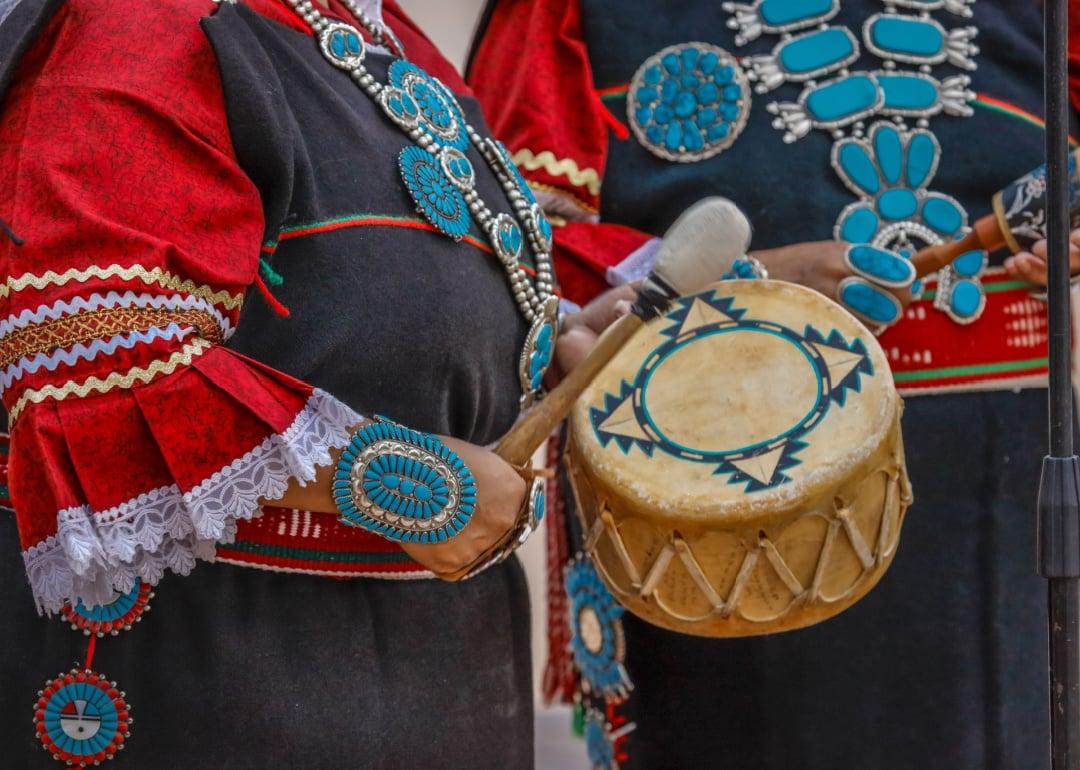
Joseph Sohm // Shutterstock
States with the biggest Native American populations
Member of Zuni tribe plays drum in ceremony in Gallup, New Mexico.
More than 5 million Native Americans live in the United States as members of 574 federally recognized and 63 state-recognized tribes. That number is projected to rise to 10 million by 2060.
A federally recognized tribe is a sovereign entity with a government-to-government relationship with the United States, as well as the rights of self-governance in such areas as tribal law and taxation.
Just 13% of Native Americans live within 324 recognized reservations. Land held in trust by the U.S. government for Native American settlement is roughly 56 million acres. The 16 million-acre Navajo Nation Reservation in Arizona, New Mexico, and Utah is the largest, and the 1.32-acre Pit River Tribe cemetery in California is the smallest.
Stacker ranked the states with the largest Native American populations using data from the Census Bureau’s 2021 American Community Survey. The Census Bureau’s definition of Native Americans includes Alaskan Natives but excludes Native Hawaiians.
Compared with other U.S. races, Native Americans have a life expectancy that is shorter by more than five years. The suicide rate among Native American youth is 2.5 times higher than among youth in the rest of the country. Native Americans are also 2.5 times more likely to experience violent crimes than the national average, and more than four out of five Native American women will experience violence in their lifetimes.
Holistically, these issues can be seen as symptoms of several larger issues, including access to social services, educational opportunities, nutritional food, and health care.
Property rights pose more significant problems, insomuch as residents who don’t have deeds to the land on which they live struggle to build credit, which throws a significant barrier in front of upward mobility. Meanwhile, tribal lands are tough sells for franchises and other commercial developers that would bring jobs to reservations, as these companies are often resistant to negotiating contract terms under tribal law.
One effort to mitigate the aforementioned statistics came with the 1968 establishment of the “American Indian” Movement in Minnesota, which advocated for sovereignty and rights. The group famously occupied the Wounded Knee battle site at the Pine Ridge Reservation for more than two months in 1973.
Rep. Deb Haaland, a member of the Laguna Pueblo in New Mexico, has since been tapped to head the U.S. Department of Interior for President Joe Biden’s administration, becoming the first Indigenous Cabinet secretary in the nation. Among her responsibilities will be the underfunded Bureau of Indian Education and the Bureau of Indian Affairs, the latter of which oversees all tribal land under U.S. trust.
Keep reading to find out which states have the biggest Native American populations.
You may also like: LGBTQ+ history before Stonewall
![]()
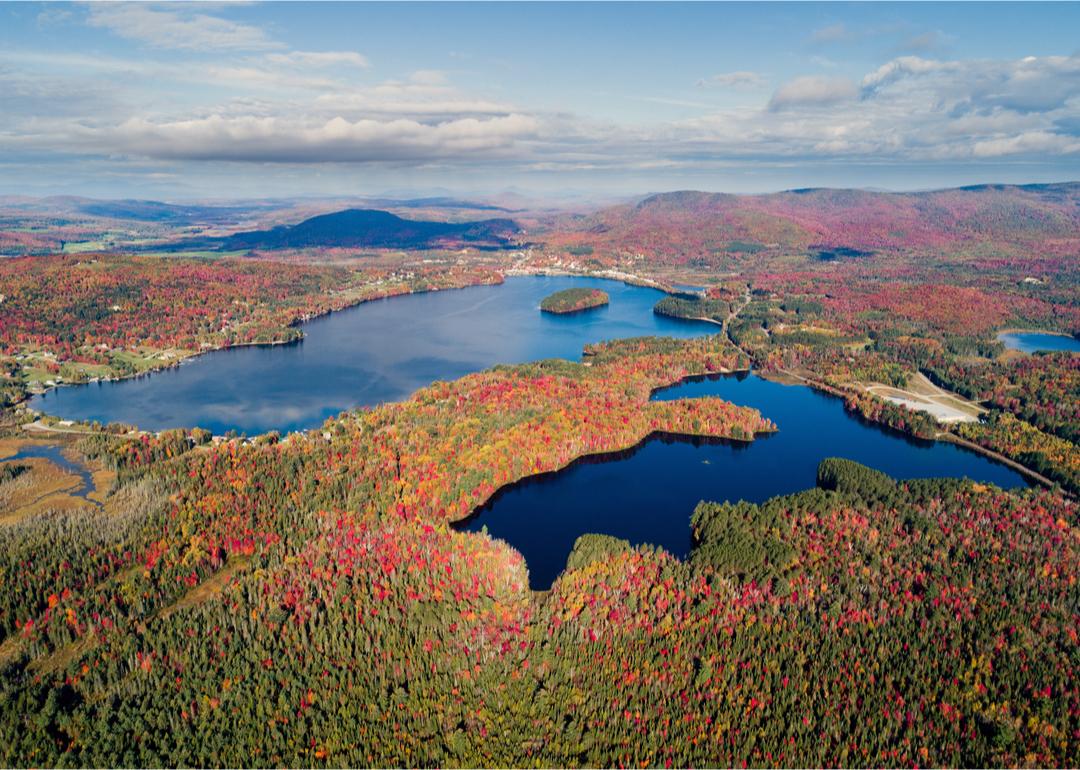
NEKVT // Shutterstock
#51. Vermont
– Native American population: 1,234
– Proportion of state’s population: 0.2% (#47 highest among all states)
Most Indigenous people left Vermont in the 1600s, and many of their descendants live on reservations in Canada. Native Americans in Vermont today are predominantly Abenaki, descendants of a semi-nomadic tribe that once spread across New England and southern Quebec, New Brunswick, and Nova Scotia. Concerted efforts are being made to preserve their language, arts, recipes, and indigenous crops.
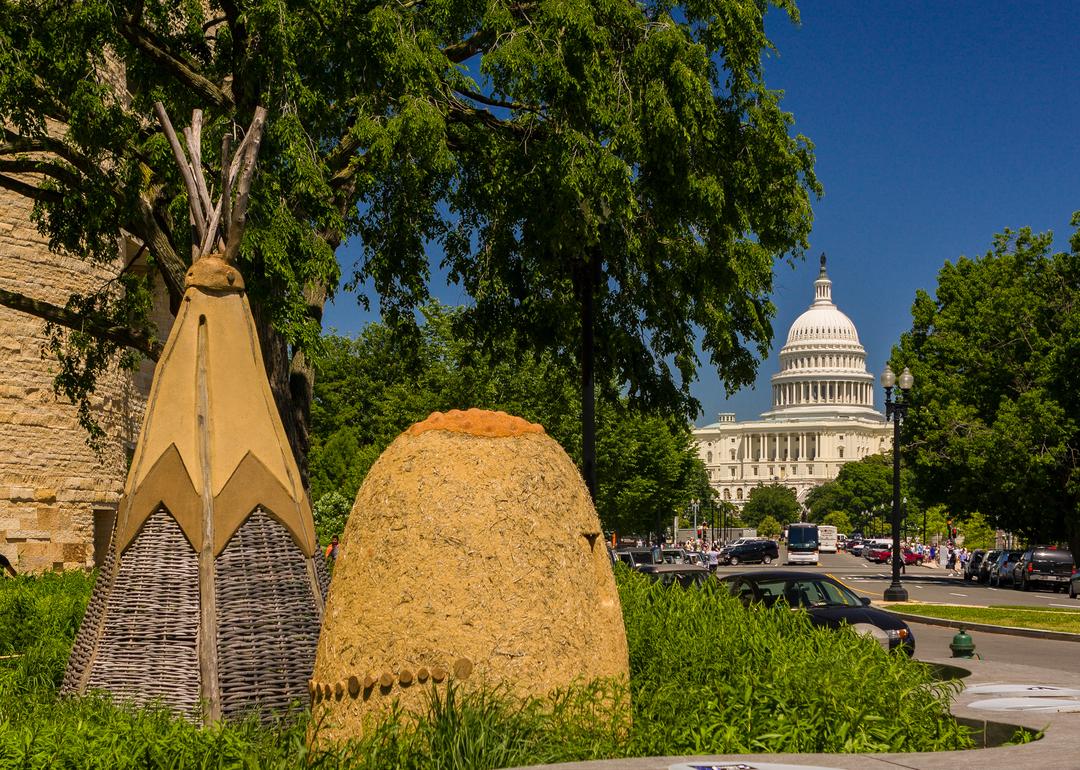
Rob Crandall // Shutterstock
#50. District of Columbia
– Native American population: 1,281
– Proportion of state’s population: 0.2% (#46 highest among all states)
The District of Columbia is located on lands that were once home to the Nacotchtank, or Anacostans, along the Anacostia River. Advocates have sought to raise the tribe’s historic profile with a campaign to mark the locales where members once lived and farmed. No descendants are believed to have survived.
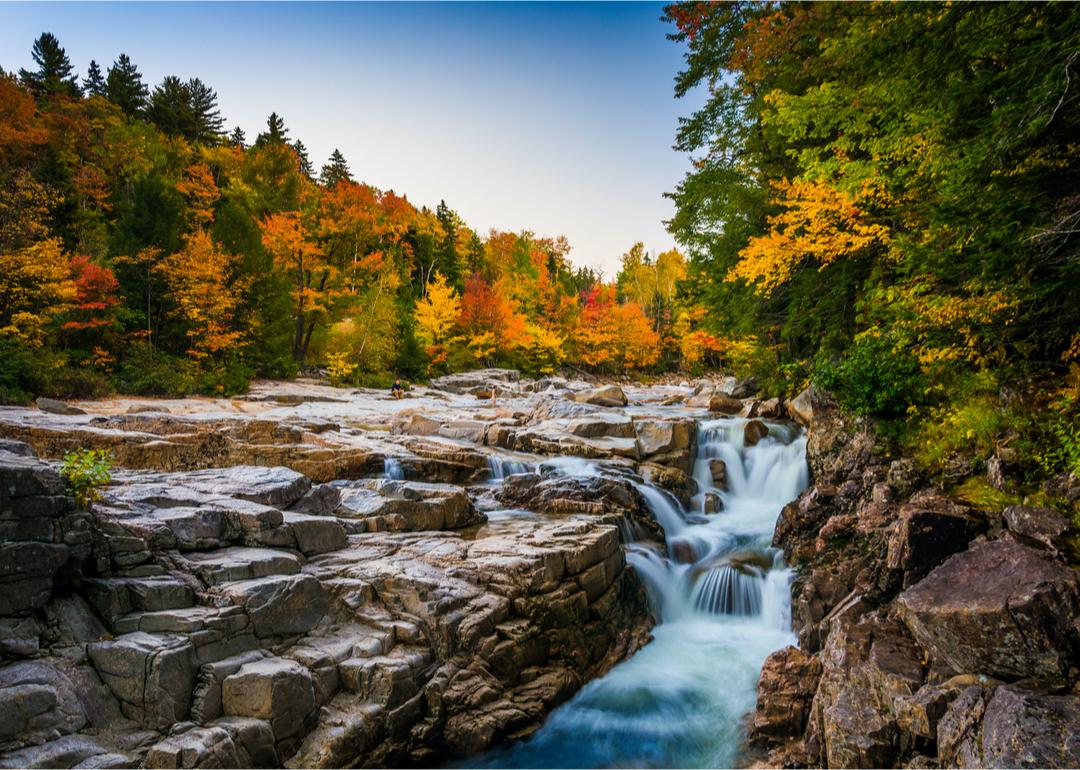
Jon Bilous // Shutterstock
#49. New Hampshire
– Native American population: 1,550
– Proportion of state’s population: 0.1% (#51 highest among all states)
The Native Americans in modern-day New Hampshire have links to two groups who lived in the region when European settlers arrived: the Abenaki and Western Pennacook. Both groups were nearly gone by the mid-1700s, having died or been enslaved, displaced, or married into non-native families. They left well-known New Hampshire names like Merrimack, Nashua, and Winnipesaukee.
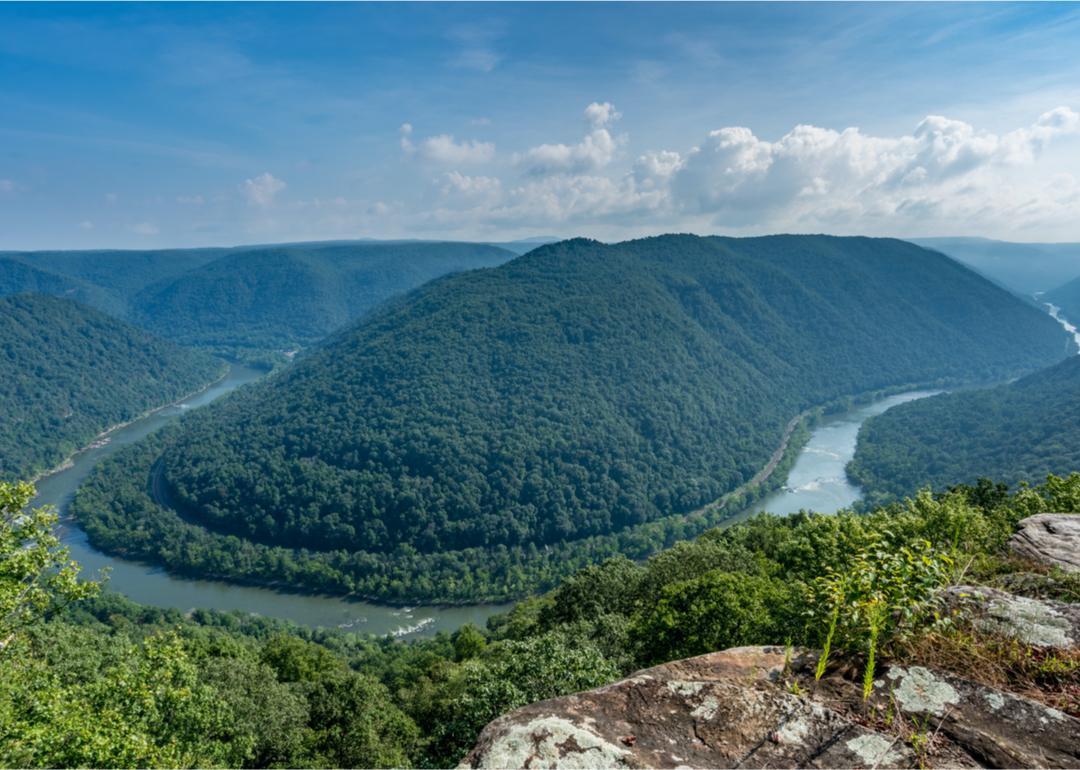
Steve Heap // Shutterstock
#48. West Virginia
– Native American population: 2,277
– Proportion of state’s population: 0.1% (#50 highest among all states)
Native Americans in West Virginia are descendants of the Shawnee and Cherokee tribes who were displaced to Oklahoma by the 1800s. Lake Shawnee Amusement Park, abandoned in 1966, was the site of a gruesome conflict in the late 1800s. Centuries later, that land is believed to be cursed and haunted after a half-dozen children perished on the park’s rides.
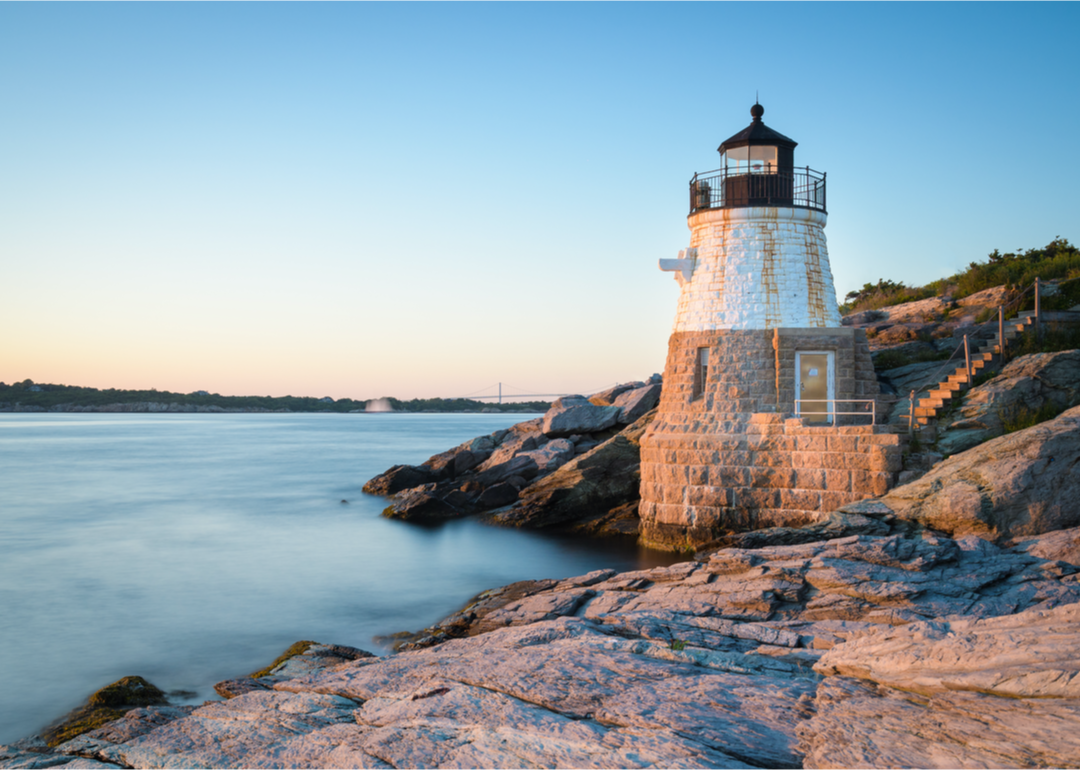
Jim Schubert // Shutterstock
#47. Rhode Island
– Native American population: 3,297
– Proportion of state’s population: 0.3% (#40 highest among all states)
Native Americans in Rhode Island today are Narragansett, descending from a tribe that has lived in the area for thousands of years. They were stripped of their tribal recognition (detribalized) by the state in the late 1800s but battled to reclaim their land in the 1970s and gained federal recognition in the 1980s. The Narragansett reservation, which was 15,000 acres at the end of the 18th century, now totals about 1,800 acres.
You may also like: Evolution of road safety standards
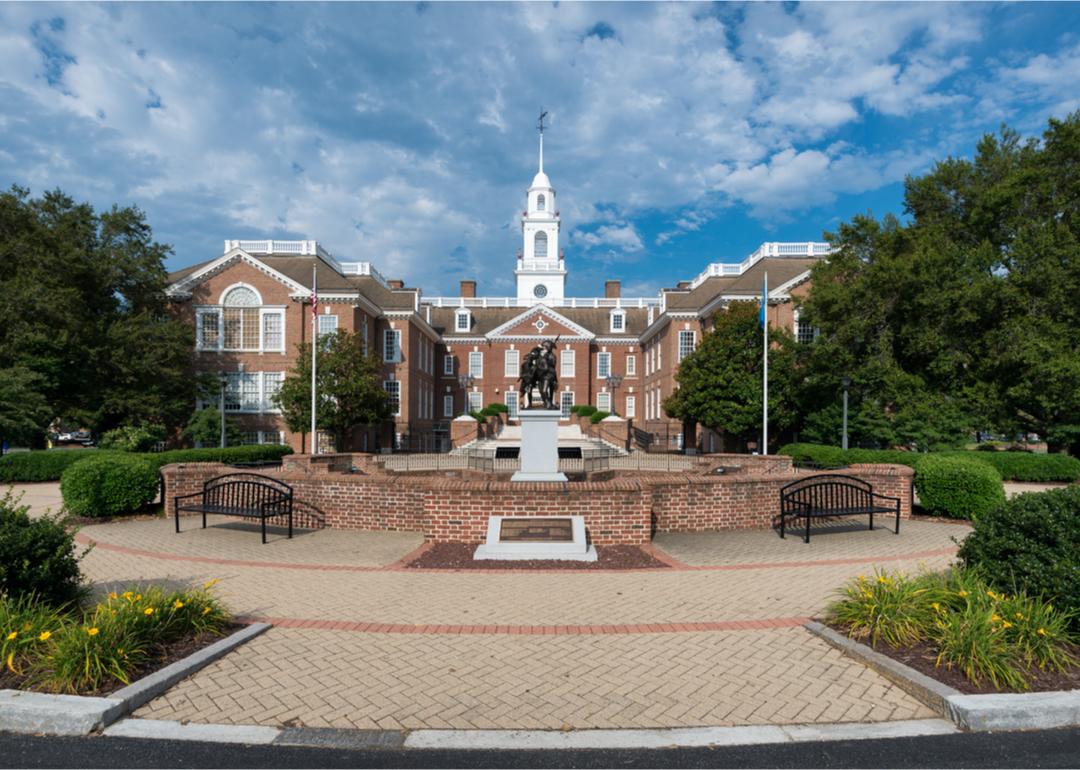
Nagel Photography // Shutterstock
#46. Delaware
– Native American population: 3,385
– Proportion of state’s population: 0.3% (#38 highest among all states)
The Delaware—or Lenape—tribe is based in Oklahoma, where members were forcibly removed from their ancestral home along the Delaware River. The name originated with Lord de la Warr, who was named governor of the English colony at Jamestown, Virginia, in 1610. The modern-day Lenapes living in Delaware have undertaken projects to map ancestral sites, cultivate specific plants, and study fishing traditions to protect and preserve Indigenous culture.
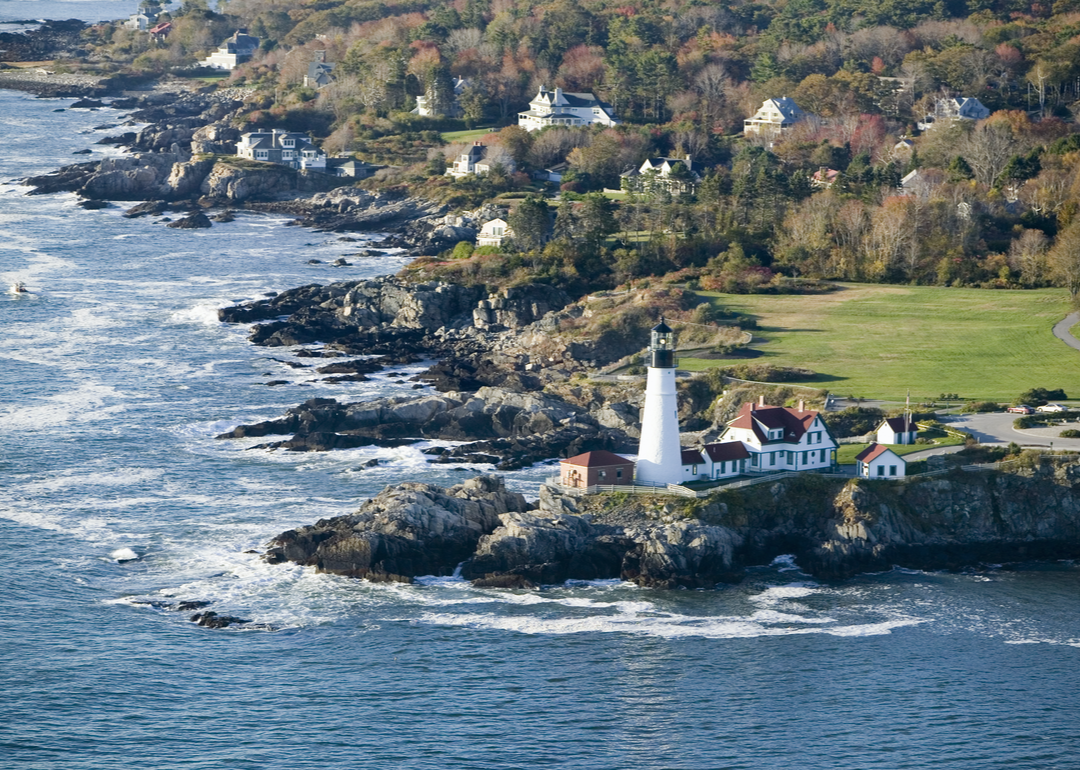
Joseph Sohm // Shutterstock
#45. Maine
– Native American population: 4,770
– Proportion of state’s population: 0.3% (#36 highest among all states)
Maine’s four Indian tribes are the Micmac, Maliseet, Penobscot, and Passamaquoddy, which, in June 2020, formed the collective Wabanaki Alliance to promote tribal sovereignty. The University of Maine waives tuition and fees as well as room and board for students who are members or have a parent or grandparent listed on a tribal census. Maine is the only state to have a complete ban (signed into law in 2019) on Native American mascots or names for sports teams, though other states have banned such uses in public schools.
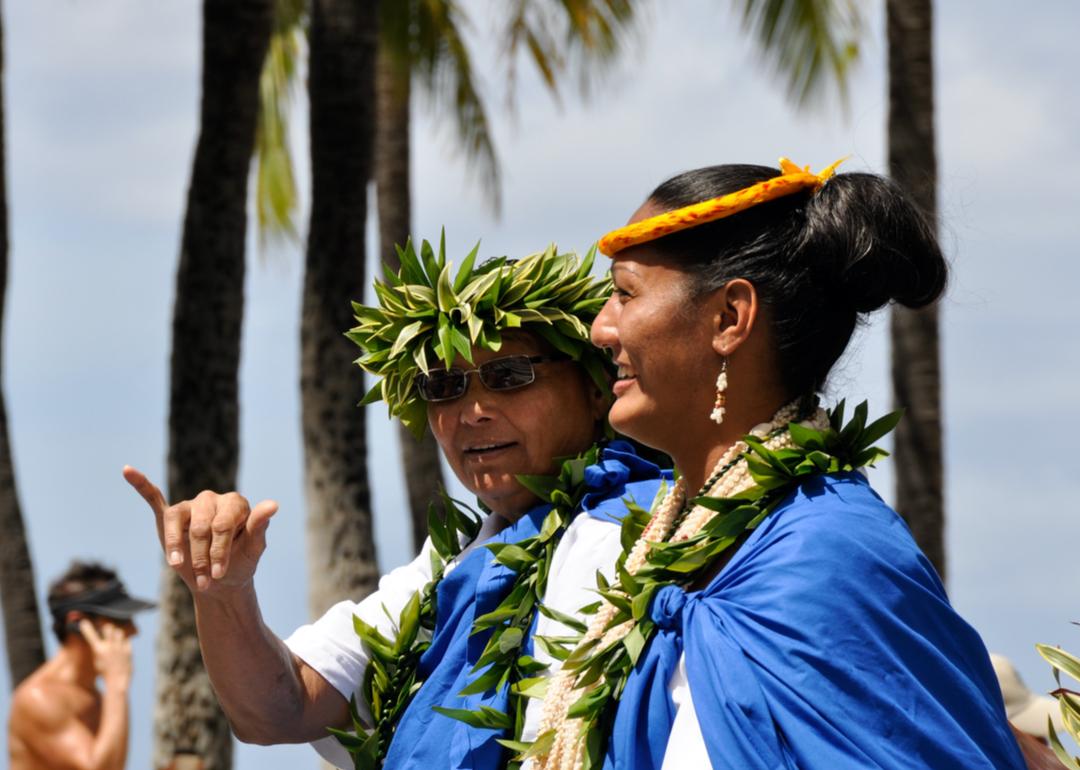
Alberto Loyo // Shutterstock
#44. Hawaii
– Native American population: 4,837
– Proportion of state’s population: 0.3% (#39 highest among all states)
Native Hawaiians, who make up more than a quarter of the state’s population, are distinct from Native Americans. Native Hawaiians are an aboriginal people descended from Polynesians who discovered the islands more than 1,000 years ago. Their monarchy was overthrown and their territory annexed, with backing from the U.S. government, at the end of the 1800s. That takeover was urged on by American sugar plantation owners there.
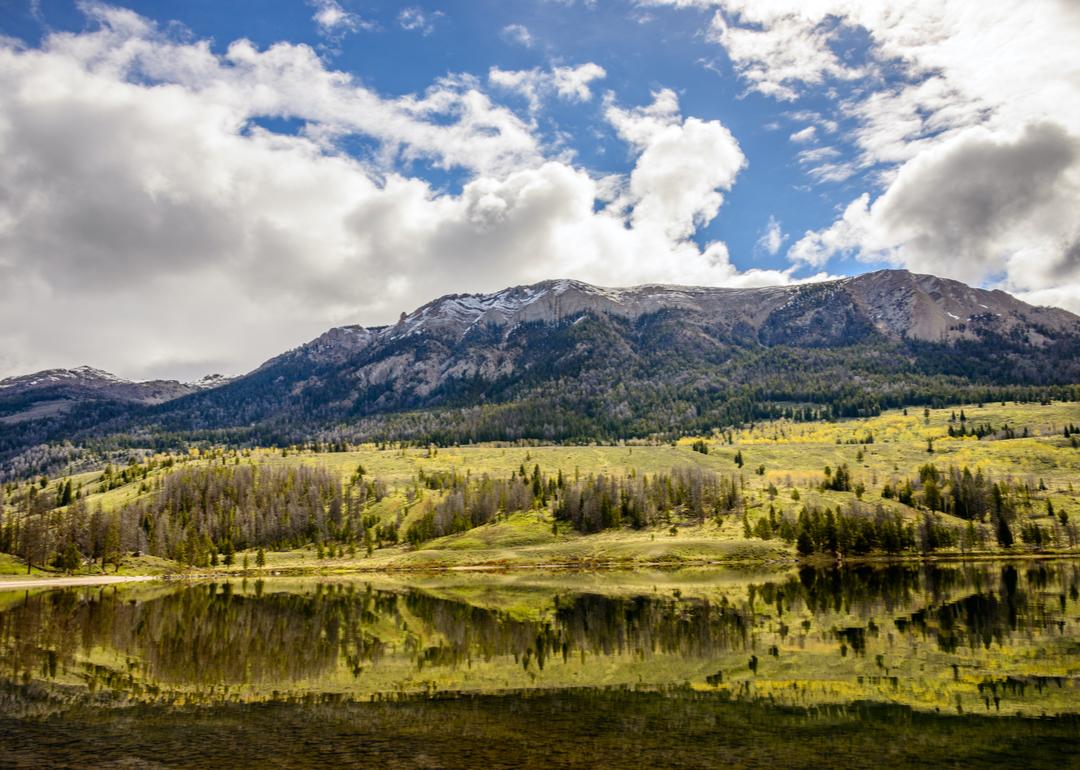
Zack Frank // Shutterstock
#43. Wyoming
– Native American population: 10,356
– Proportion of state’s population: 1.8% (#8 highest among all states)
Two federally recognized tribes, the Shoshone and Arapaho, share the Wind River Reservation of more than 2.2 million acres in Wyoming. The reservation has a severe lack of affordable housing, which has forced people to live in overcrowded homes. Multiple families sharing small homes has made it difficult for the tribal community to take necessary precautions against the spread of the coronavirus. Early in the pandemic, Native Americans accounted for more than 42% of the state’s coronavirus deaths, despite comprising just 2.3% of the population. The Wind River Reservation has since implemented the strictest COVID-19 policy in the entire state.
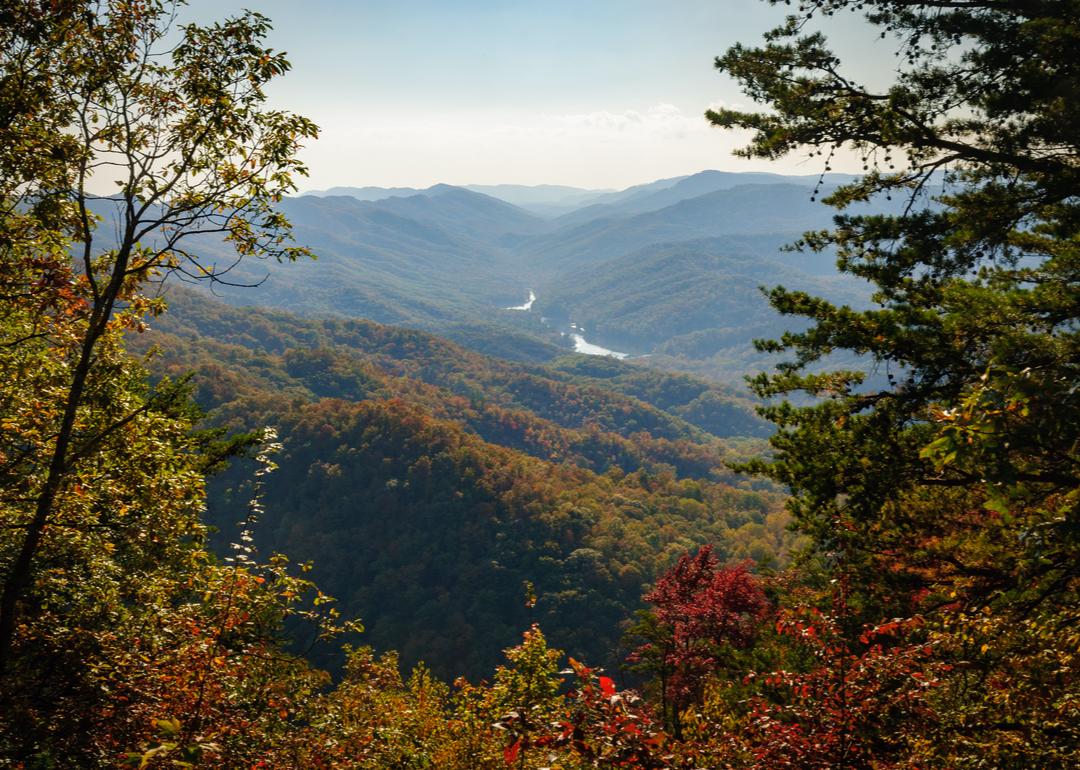
Zack Frank // Shutterstock
#42. Kentucky
– Native American population: 10,357
– Proportion of state’s population: 0.2% (#44 highest among all states)
Kentucky was once home to an array of tribes including the Shawnee, Cherokee, Chickasaw, and Choctaw, and many Native Americans there today are descendants of those who intermarried or otherwise eluded forced displacement. In 1987, a group of men paid the property owner of what was then known as Slack Farm—situated on the site of a former Native American burial site in Union County—$10,000 to allow them to dig up graves and take relics. The grave desecration attracted public and media attention and prompted Congress to pass legislation for the protection and repatriation of Indigenous remains and sacred objects.
You may also like: What the 50 biggest cities in America looked like 50 years ago
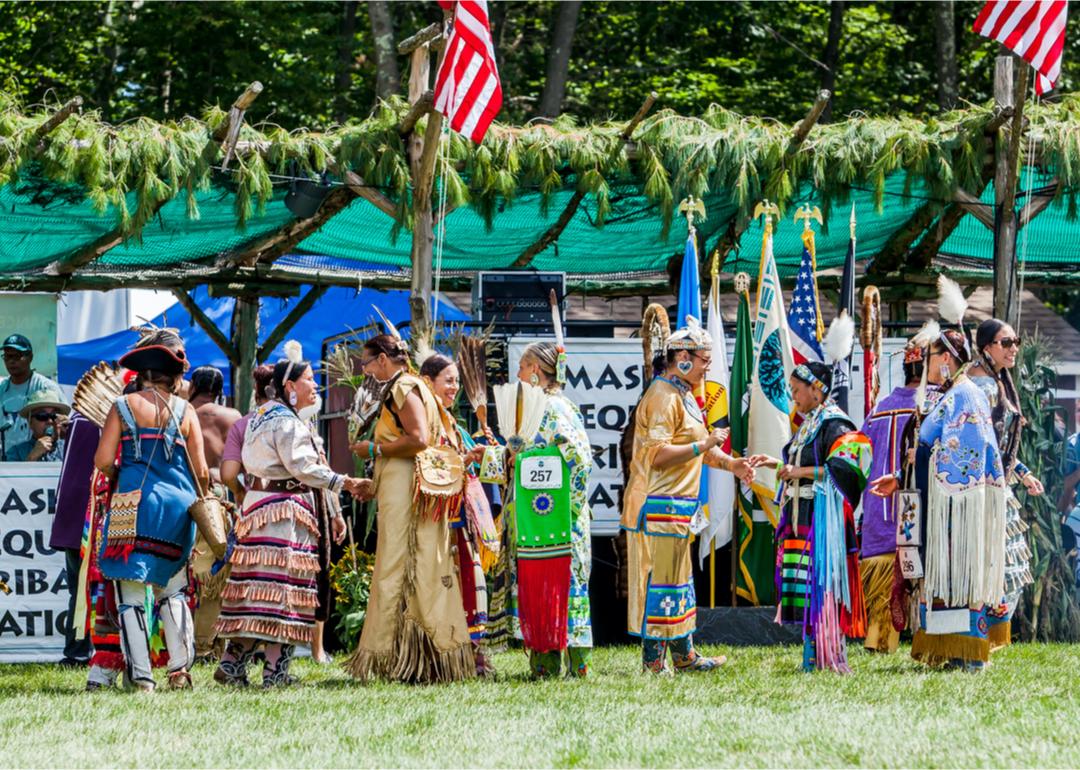
Miro Vrlik Photography / Shutterstock
#41. Connecticut
– Native American population: 12,238
– Proportion of state’s population: 0.3% (#37 highest among all states)
Connecticut has five recognized tribes—the Golden Hill Paugussett, Mashantucket Pequot, Mohegan, Paucatuc Eastern Pequot, and Schaghticoke—that hold six reservations. The Mohegan Tribe built the huge Mohegan Sun resort and entertainment complex, which boasts luxury hotels, two casinos, shopping, dining, meeting facilities, and venues for concerts and sporting events all within a two-hour drive from New York City.
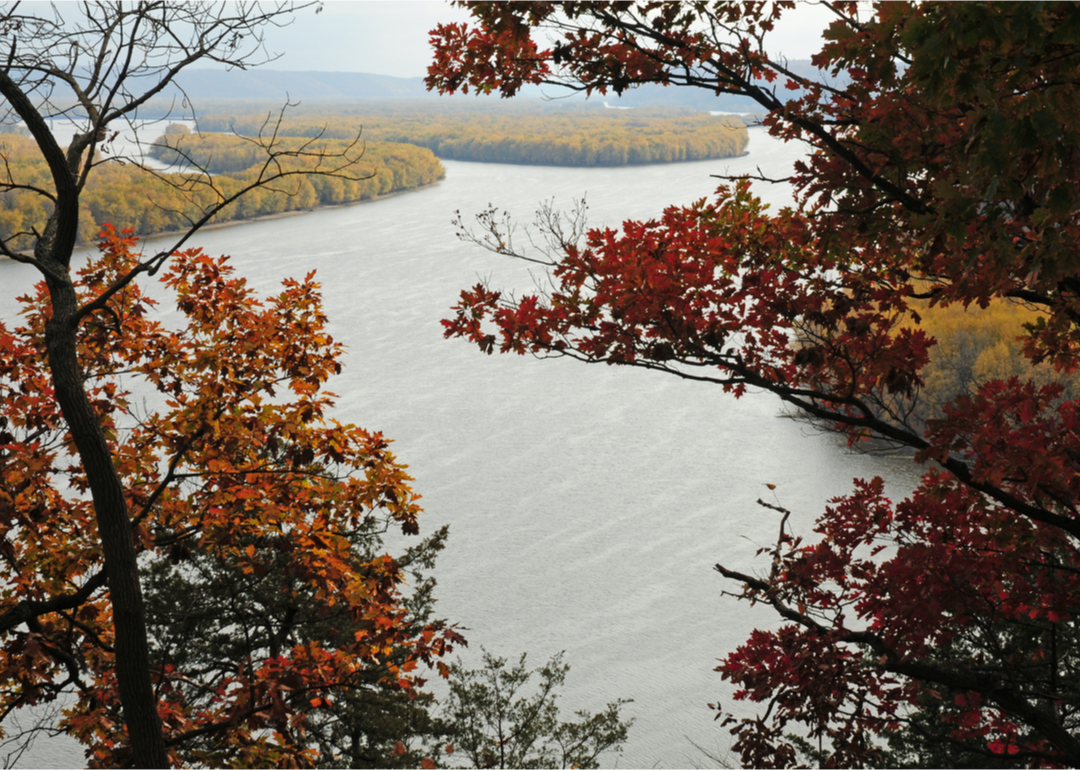
Nancy Bauer // Shutterstock
#40. Iowa
– Native American population: 15,288
– Proportion of state’s population: 0.5% (#30 highest among all states)
Like all other Indigenous tribes in the state, the Meskwaki were forced out of Iowa, mostly to Kansas, by 1850. They returned seven years later to buy land along the Iowa River, where the tribe continues to live. The tribe’s private land gave the Meskwaki autonomy unlike that found on a reservation. Today, the Meskwaki owns more than 8,100 acres across three counties, operating schools, farms, businesses, and economic diversification projects to expand job opportunities in the region.
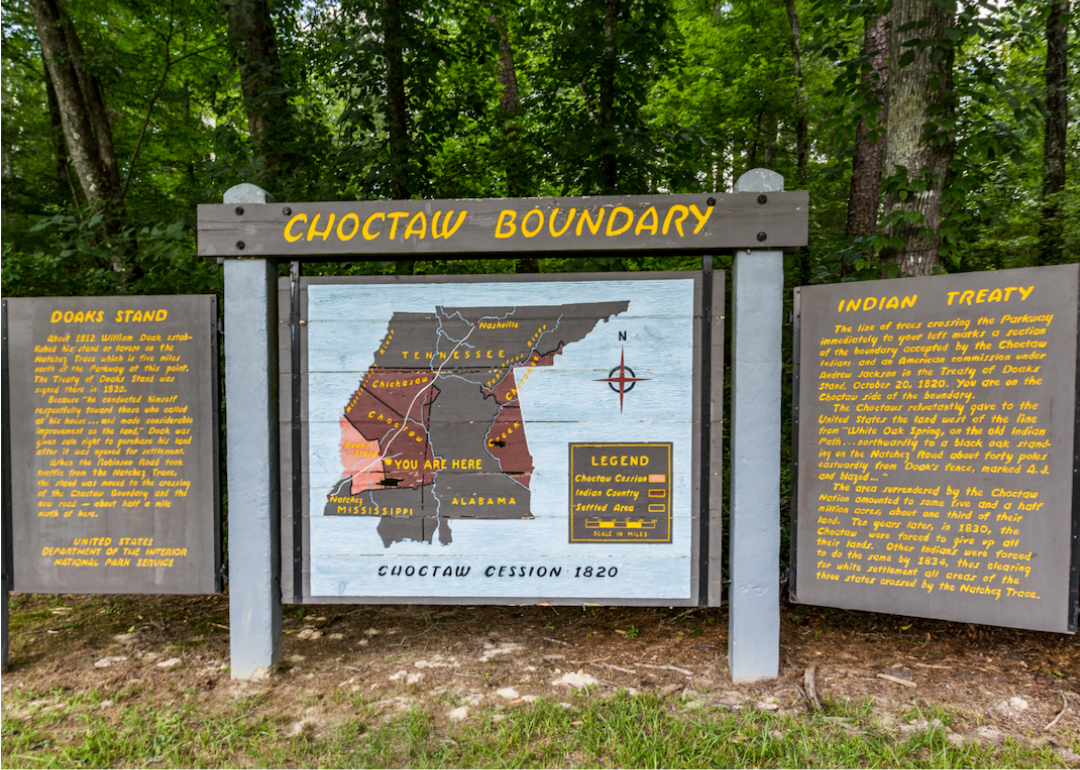
Tony Webster // Wikimedia Commons
#39. Mississippi
– Native American population: 15,648
– Proportion of state’s population: 0.5% (#25 highest among all states)
Only the Choctaw Indians are federally recognized in Mississippi, which once was home to the Biloxi, Chickasaw, Houma, Natchez, Ofo, Quapaw, Tunica, and other tribes. Members of the Mississippi Band of Choctaw Indians are descendants of those who managed not to be forcibly removed to Oklahoma in the 1830s but remained to face racism, segregation, and poverty. The coronavirus has taken a heavy toll on the Mississippi Choctaw, who comprise less than 1% of the population but 4.5% of COVID-related deaths. Medical experts attribute the disproportionate death rate to underlying health conditions in the community including heart disease, diabetes, and high blood pressure.
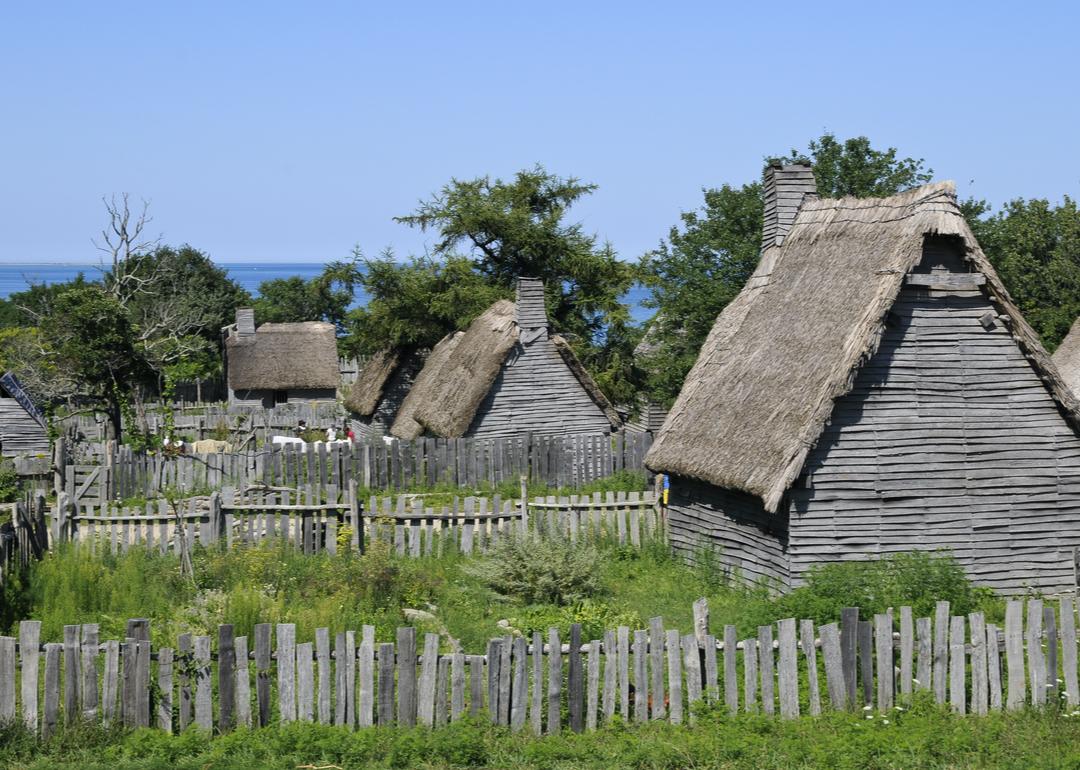
Andreas Juergensmeier // Shutterstock
#38. Massachusetts
– Native American population: 15,835
– Proportion of state’s population: 0.2% (#45 highest among all states)
The Mashpee Wampanoag, one of two federally recognized tribes in Massachusetts, live on tribal land in Taunton and on Cape Cod—their ancestors are part of the 17th-century Plymouth Thanksgiving tale. Control over the tribe’s Cape Cod land has been embroiled in legal wrangling with the federal government, and rights to the Taunton property where a $1 billion casino, hotel, and entertainment complex is planned, have been contested by other, unrecognized tribes, including the Mattakeeset Massachuset. The other recognized tribe, the Aquinnah Wampanoag, holds tribal lands on Martha’s Vineyard, where it has housing and several businesses, including three stores and a shellfish hatchery.
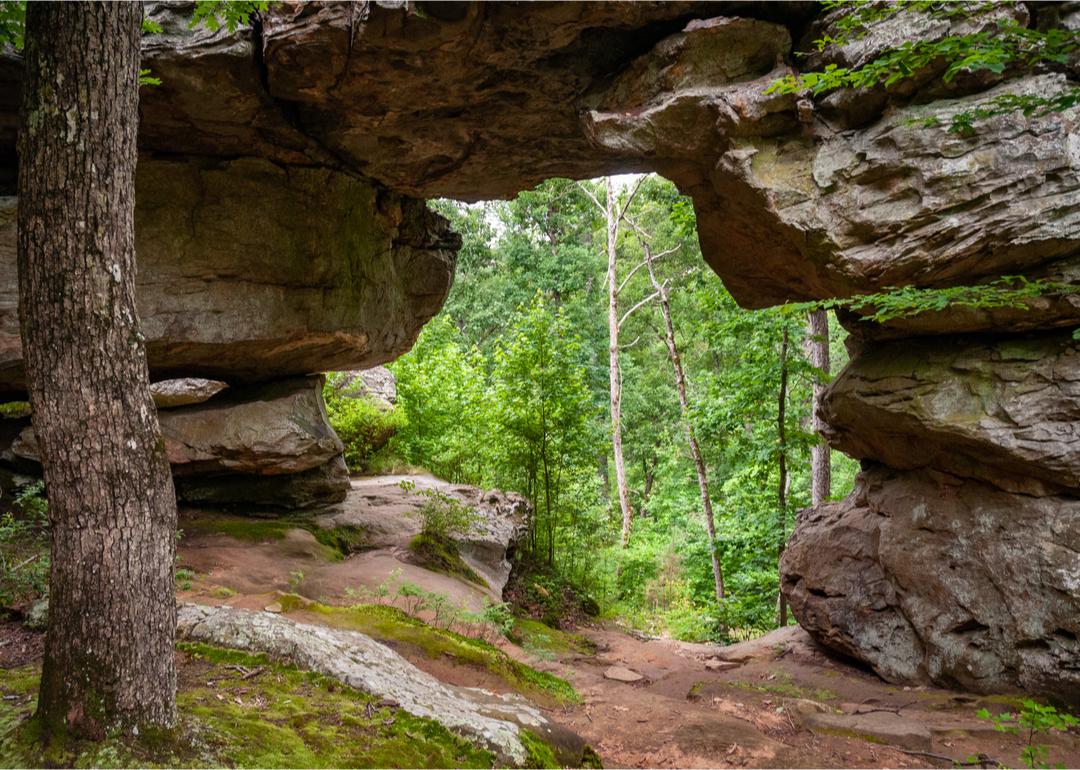
Zack Frank // Shutterstock
#37. Arkansas
– Native American population: 17,058
– Proportion of state’s population: 0.6% (#24 highest among all states)
The ancestors of many Native Americans living today in Arkansas were Cherokee forcibly moved westward from their ancestral homes in North Carolina. Other tribes in the state are the Quapaw and Caddo nations. The routes along the Trail of Tears, which forced Native Americans from the Southeast west toward Oklahoma in the 1830s, all passed through Arkansas. Researchers today continue to study the land and water pathways that carried some 60,000 displaced people through the state.
You may also like: Major civil rights moments in every state
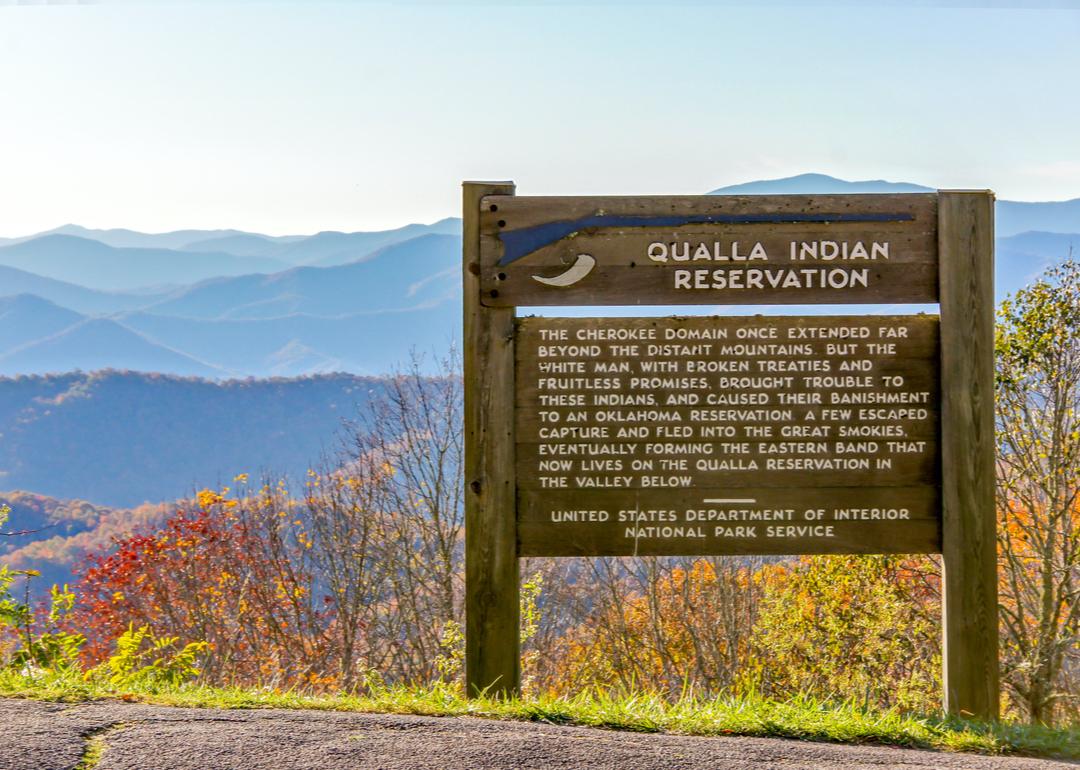
starryvoyage // Shutterstock
#36. Tennessee
– Native American population: 18,070
– Proportion of state’s population: 0.3% (#43 highest among all states)
No tribes are officially recognized in Tennessee, although there is a Choctaw community and the Muscogee “Creek” Nation Citizens. Members from several have been seeking recognition, however, including the Cherokee Wolf Clan, Upper Cumberland Cherokee, Remnant Yuchi Nation, Far Away Cherokee, and Chikamaka Cherokee. In the 18th century, the Cherokee, the only remaining Indigenous people, were forcibly removed to Oklahoma, though a few remained behind, hiding in the mountains.
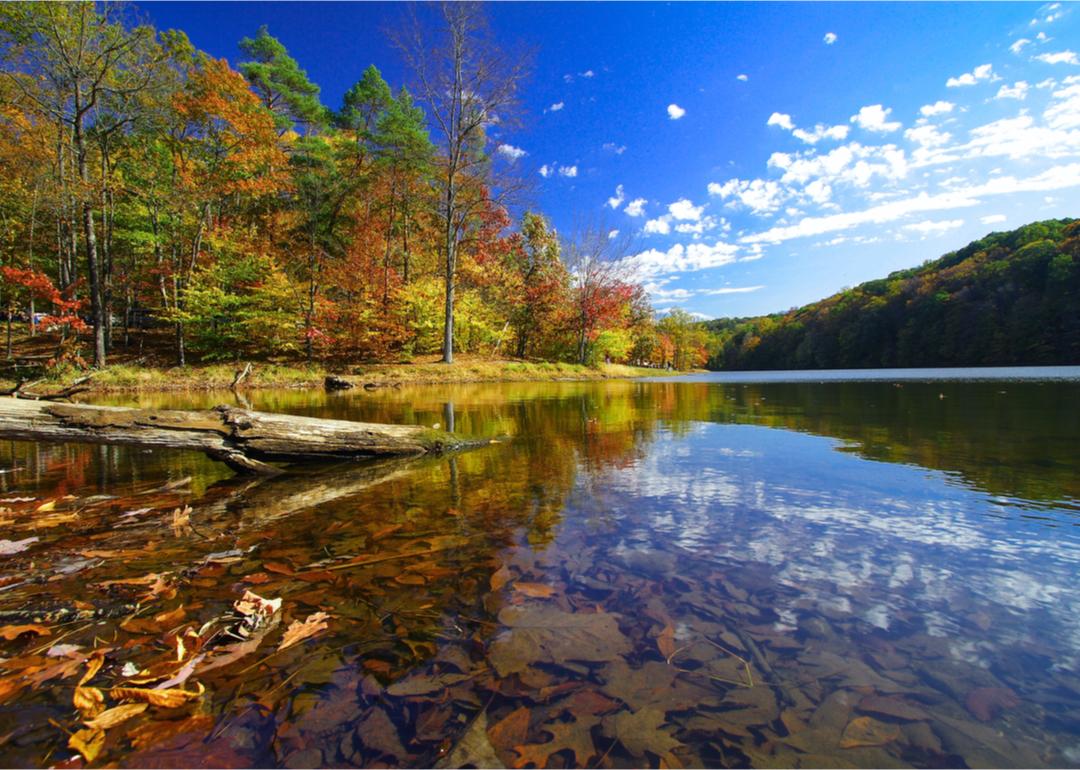
Aeypix // Shutterstock
#35. Indiana
– Native American population: 19,174
– Proportion of state’s population: 0.3% (#42 highest among all states)
Many members of the Pokagon Band of Potawatomi, a federally recognized tribe in Michigan, live in northern Indiana. Once spread across four states, most Potawatomi tribes were forcibly moved west in 1838, but the Pokagon were allowed to remain. Others in Indiana are the Miami, who run a complex in the city of Peru with a tribal council and government, a food pantry, and cultural projects and events. Most of the Miami tribe members were also forced west in the mid-1800s, but individual landowners were allowed to stay.
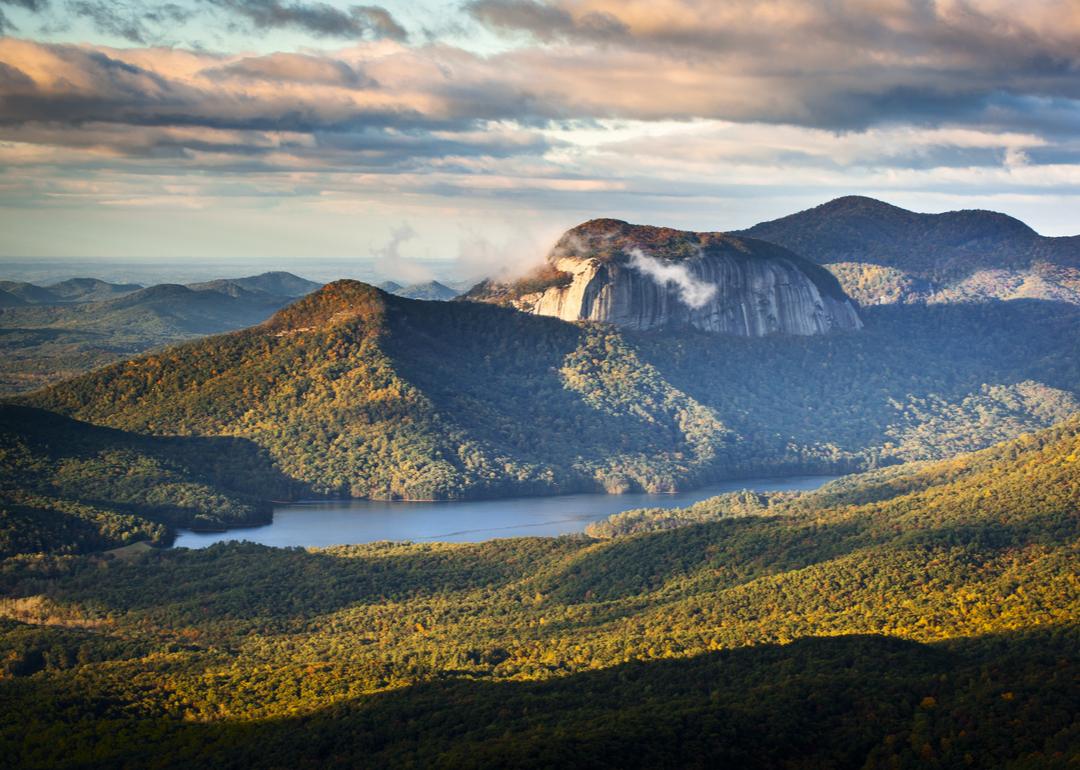
Dave Allen Photography // Shutterstock
#34. South Carolina
– Native American population: 19,948
– Proportion of state’s population: 0.4% (#34 highest among all states)
More than a half-dozen tribes have state recognition in South Carolina, among them the Beaver Creek, Edisto Natchez Kusso, Pee Dee, and Waccamaw. The sole federally recognized tribe, the Catawba, has a reservation near Rock Hill. In 2020, the federal government approved the Catawba’s use of 16 acres across the border in North Carolina to build an entertainment and casino complex. The plan was opposed by the Eastern Band of Cherokee, which operates two casinos in the western part of North Carolina and said investments and jobs would be threatened by the competition. As of early 2023, construction on the Two Kings Casino was stopped due to violations of the Indian Gaming Regulatory Act.
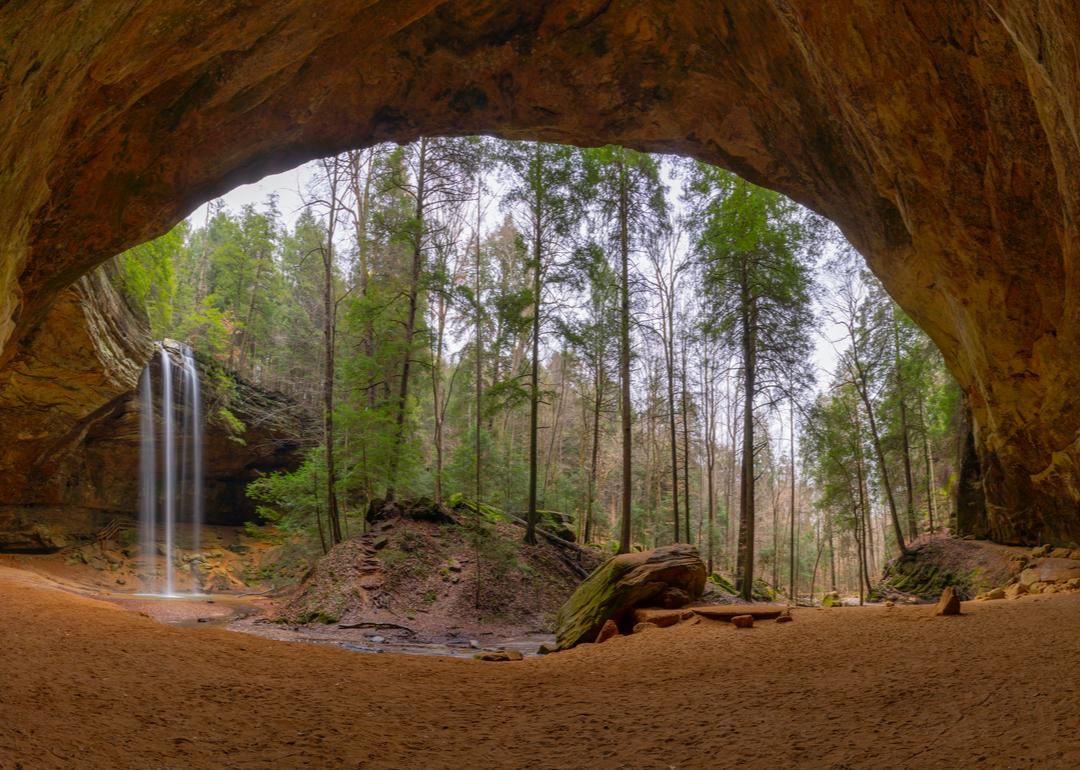
arthurgphotography // Shutterstock
#33. Ohio
– Native American population: 20,594
– Proportion of state’s population: 0.2% (#49 highest among all states)
Once home to a number of tribes like the Chippewa, Ottawa, Delaware, and Iroquois, today Ohio only recognizes the United Remnant Band of the Shawnee Nation. The Shawnee runs Project NATIVE (Native Americans Teaching Indigenous Values and Ethics), a series of hands-on cultural education programs in natural woodland settings designed to pass on traditions in music, dance, and storytelling.

Ricardo Reitmeyer // Shutterstock
#32. Kansas
– Native American population: 21,670
– Proportion of state’s population: 0.7% (#20 highest among all states)
Native Americans were forcibly moved in the early 1800s to the Kansas Territory, which was deemed unsuitable for white settlers. Almost 30 tribes were given land, only to be pushed off that land by settlers (most notably following the Civil War). Today, the state has four Indian reservations: the Iowa, Kickapoo, Potawatomi, and Sac and Fox. The Kickapoo reservation rests atop a rock formation that impedes access to groundwater, and the tribe has struggled with adequate supplies of drinking water, rights to water from the Delaware River, and a badly outdated water treatment plant.
You may also like: How much the typical home cost in your state in 1950
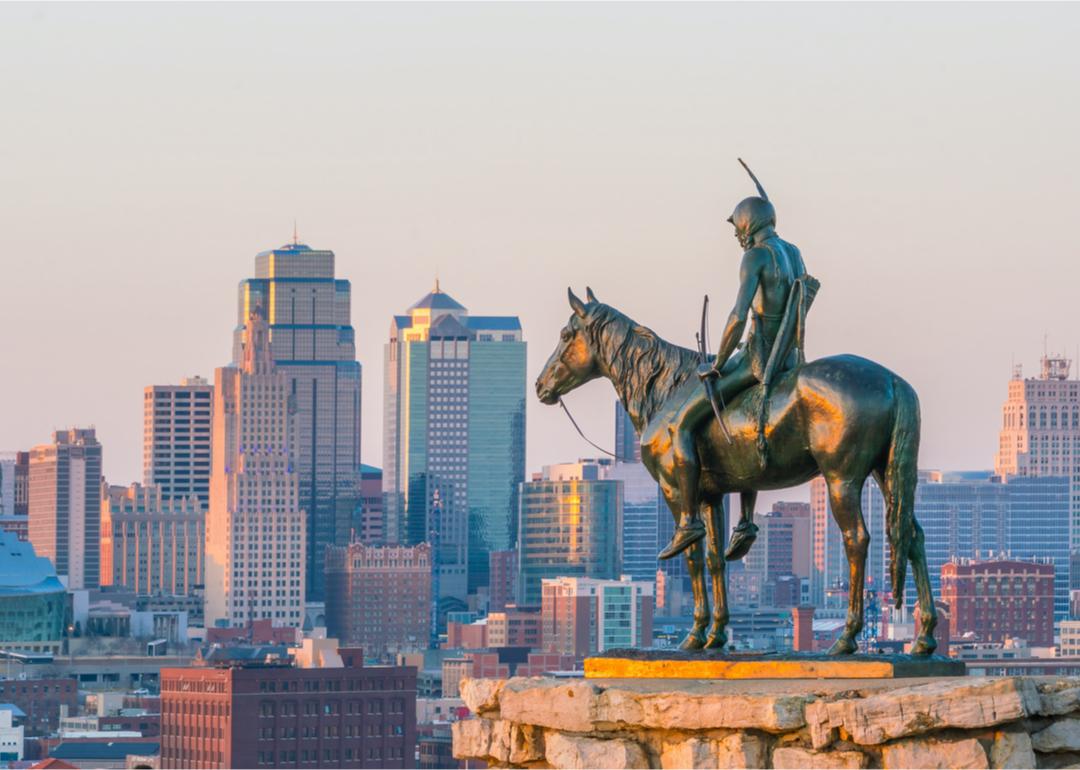
f11photo // Shutterstock
#31. Missouri
– Native American population: 22,046
– Proportion of state’s population: 0.4% (#35 highest among all states)
Its state name means “one who has dugout canoes” in the language of the Missouria people, but Missouri has no recognized tribes today. It had a Native American population of about 20,000 when it achieved statehood in 1821, most of whom had been forcibly driven to the region from ancestral homelands in the east. By the 1830s, most moved again in forced relocations out of the area.
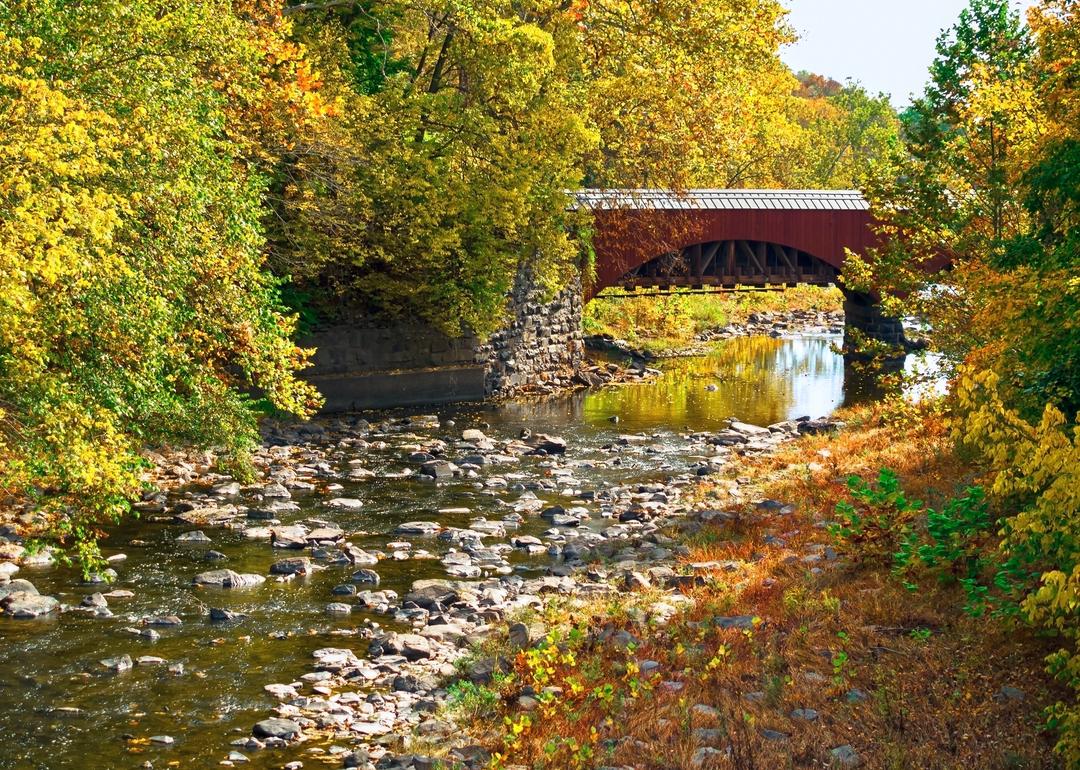
Andrew F. Kazmierski // Shutterstock
#30. Pennsylvania
– Native American population: 22,765
– Proportion of state’s population: 0.2% (#48 highest among all states)
In modern-day Pennsylvania, the Lenape Nation runs a nonprofit organization focused on raising awareness of tribal culture, traditions, and history, which includes teaching Indigenous language. Other original inhabitants of Pennsylvania like the Susquehannock were virtually wiped out by the mid-1700s.
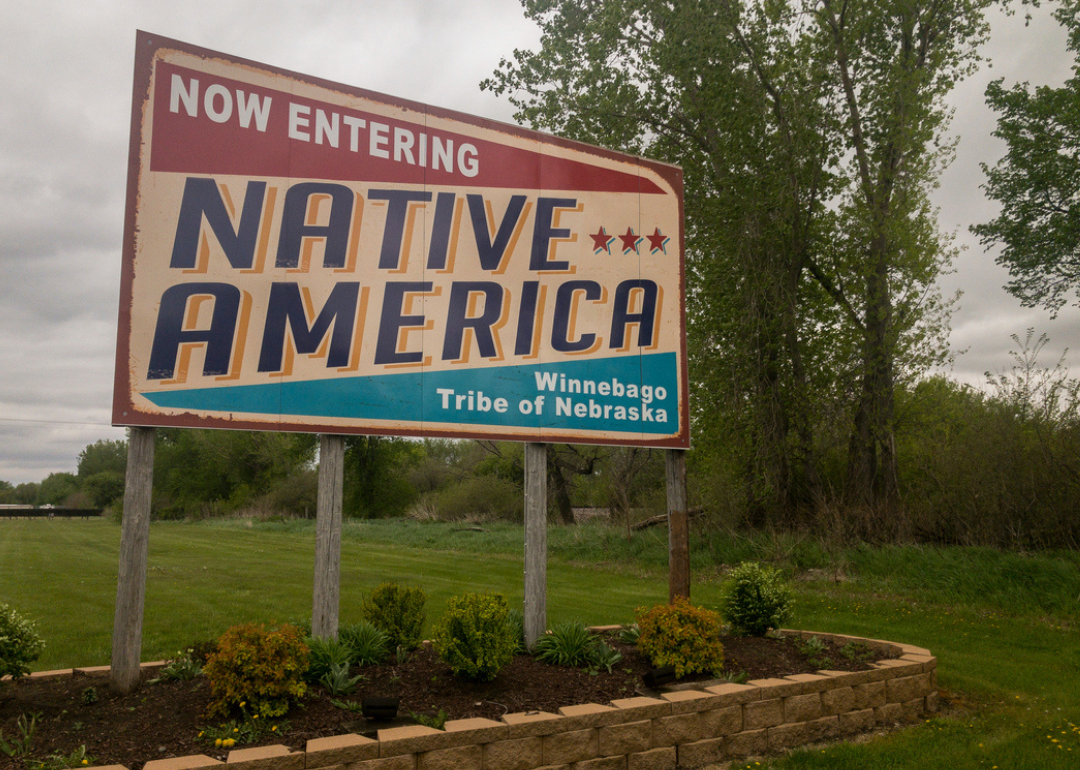
Jacob Boomsma // Shutterstock
#29. Nebraska
– Native American population: 23,547
– Proportion of state’s population: 1.2% (#14 highest among all states)
Four federally recognized tribes have reservations in Nebraska: the Omaha, Winnebago, Ponca, and Santee Sioux. Coronavirus infection and death rates have been high on the Winnebago and Omaha reservations due to the tribal members’ underlying health conditions, their crowded, multigenerational households, and their jobs in the area’s outbreak-stricken meatpacking plants. The closing of casinos on the reservations has caused severe economic problems, as well.
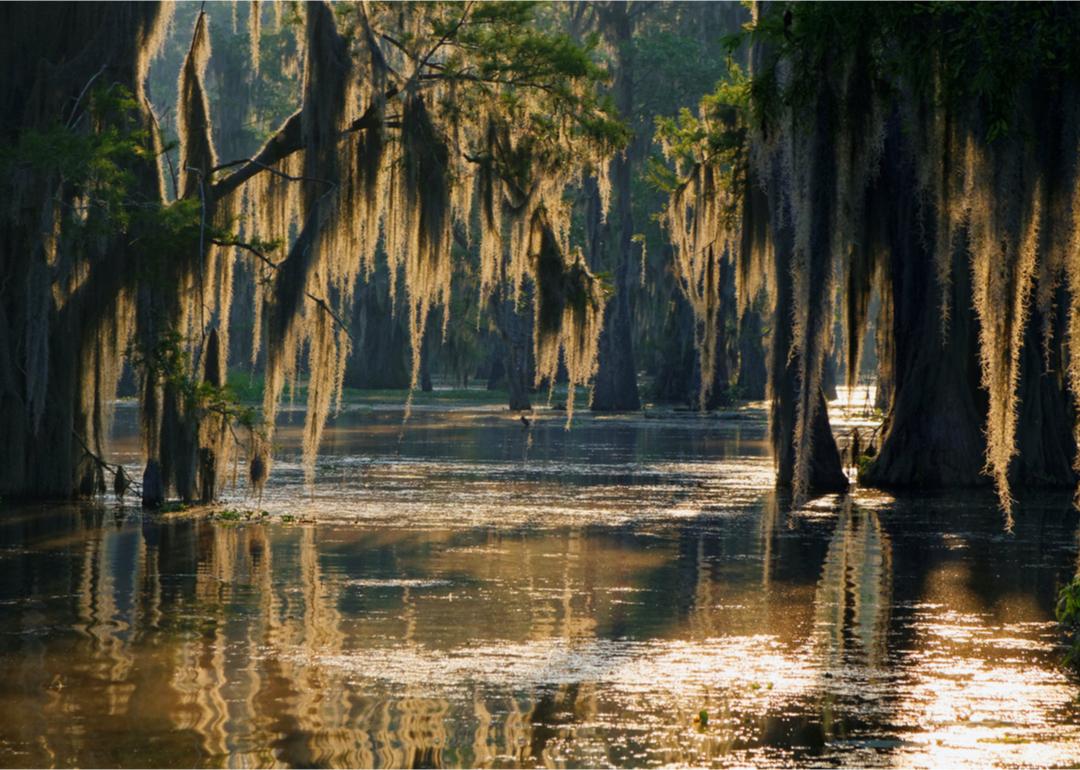
Pierre Jean Durieu // Shutterstock
#28. Louisiana
– Native American population: 23,926
– Proportion of state’s population: 0.5% (#26 highest among all states)
The Chitimacha, Coushatta, Jena Band of Choctaw Indians, and Tunica-Biloxi are federally recognized, and several others have state recognition. The Isle de Jean Charles Band live on land that is submerging rapidly amid rising sea levels, with one road to the mainland frequently impassable (their story was recounted in the 2012 film, “Beasts of the Southern Wild”). About 550 acres of farmland approximately an hour’s drive north have been purchased by the government for the tribe’s resettlement, but members are deeply divided over whether to accept the conditions of relocation.
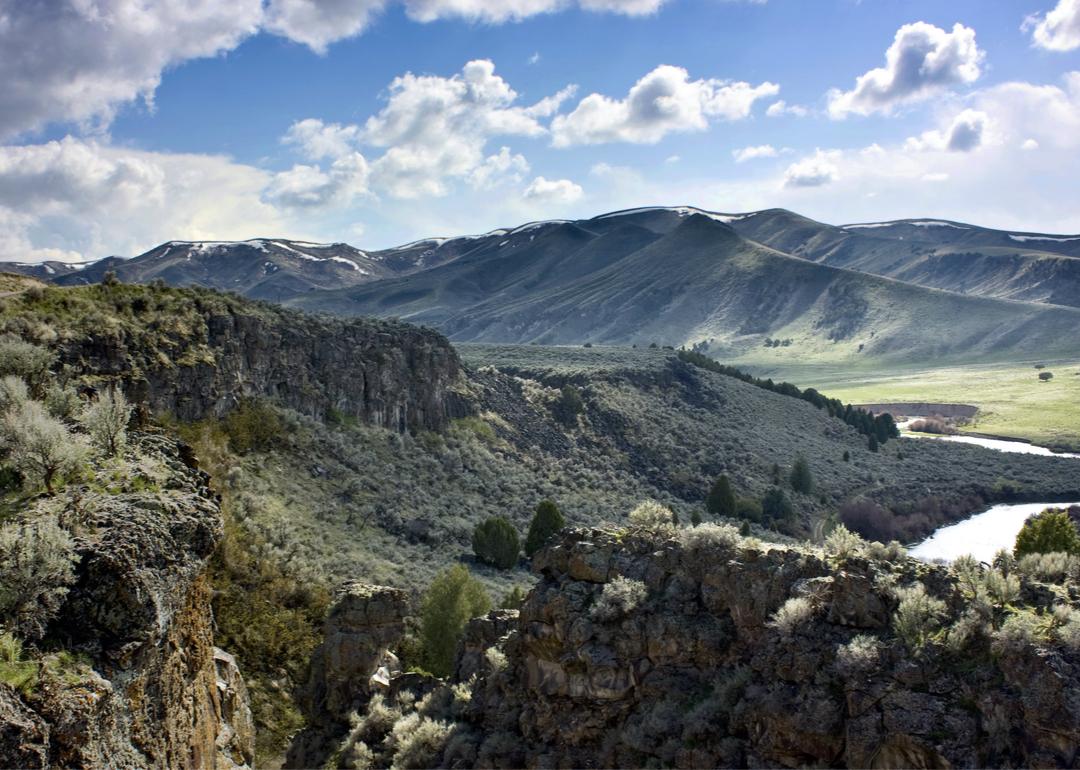
Tucker James // Shutterstock
#27. Idaho
– Native American population: 23,990
– Proportion of state’s population: 1.3% (#13 highest among all states)
Among the federally recognized tribes in Idaho, which include the Coeur D’Alene, Kootenai, and Shoshone-Bannock, the Nez Perce have the largest reservation (770,000 acres). Tribal land once stretched about 16 million acres across Washington, Oregon, and Idaho but was reduced considerably after gold was discovered. The tribe breeds prized appaloosas, operates a large fisheries program with several hatcheries, and has played a major role in saving the Chinook and Coho salmon from extinction.
You may also like: 25 iconic historic sites keeping American history alive
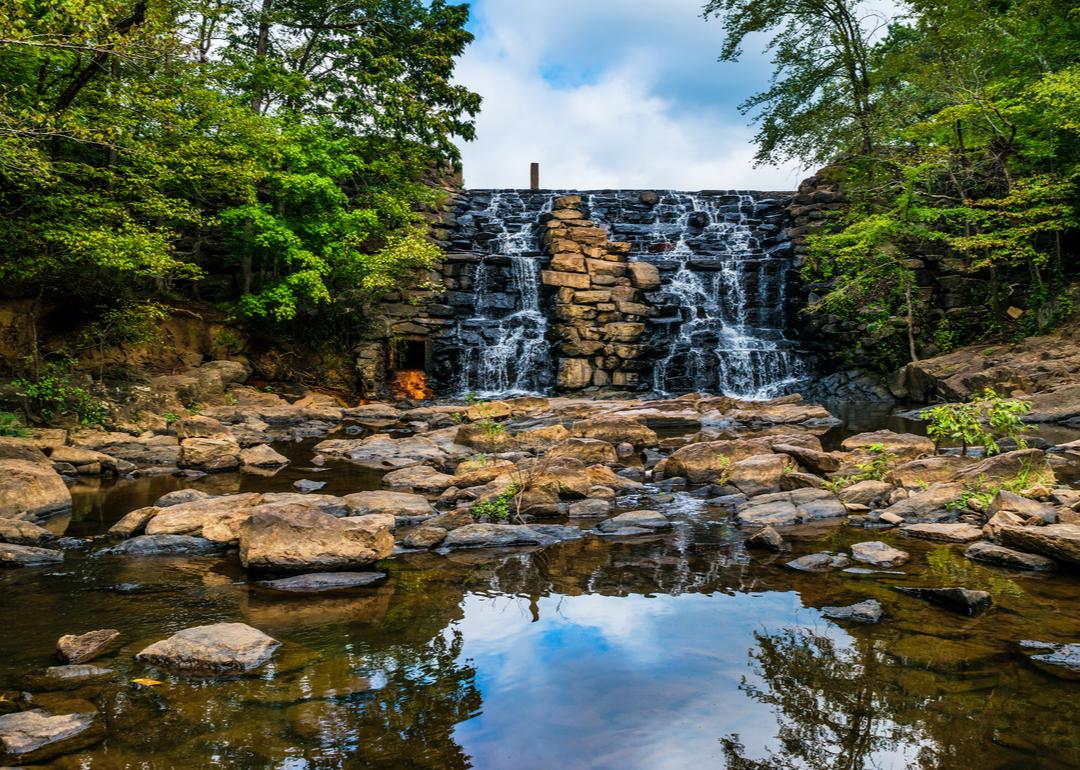
Rob Hainer // Shutterstock
#26. Alabama
– Native American population: 24,830
– Proportion of state’s population: 0.5% (#29 highest among all states)
Among the tribes recognized in Alabama are the Poarch Band of Creek Indians, Cherokee, Choctaw, and the Piqua Shawnee of the Ohio River Valley. DNA studies have placed the Piqua in the region back to between 500 B.C. and A.D. 500. The Poarch Creek, the only tribe in the state that is federally recognized as well, were not forcibly removed from their land and have a reservation in Poarch, about 60 miles east of Mobile.
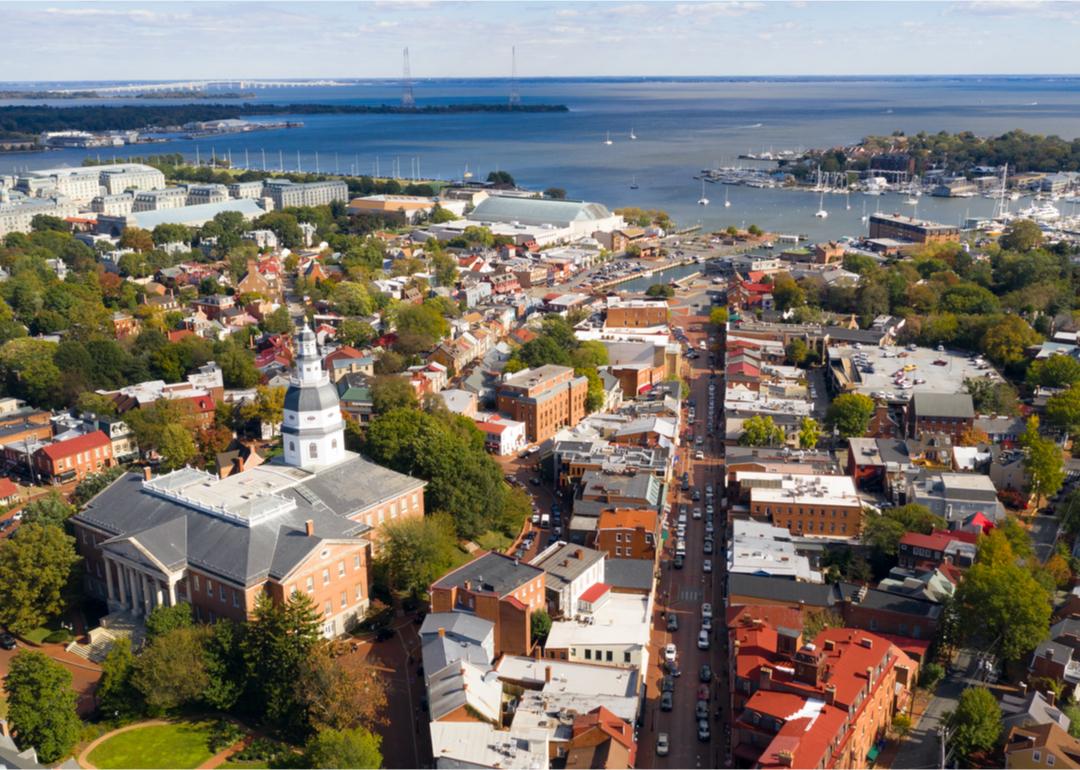
Real Window Creative // Shutterstock
#25. Maryland
– Native American population: 25,208
– Proportion of state’s population: 0.4% (#32 highest among all states)
Maryland’s Piscataway tribe all but disappeared after the end of the American Revolution, when members moved as far west as Michigan and Ontario and as far south as North Carolina. Some descendants in southern Maryland worked to gain state recognition, which was granted in 2012, thanks in part to family records kept by the Catholic Church that proved tribal membership. Tribal members celebrate traditions like the Seed Gathering in spring, Feast from the Waters in early summer, Green Corn Festival in late summer, and Greeting of the Geese in late fall.
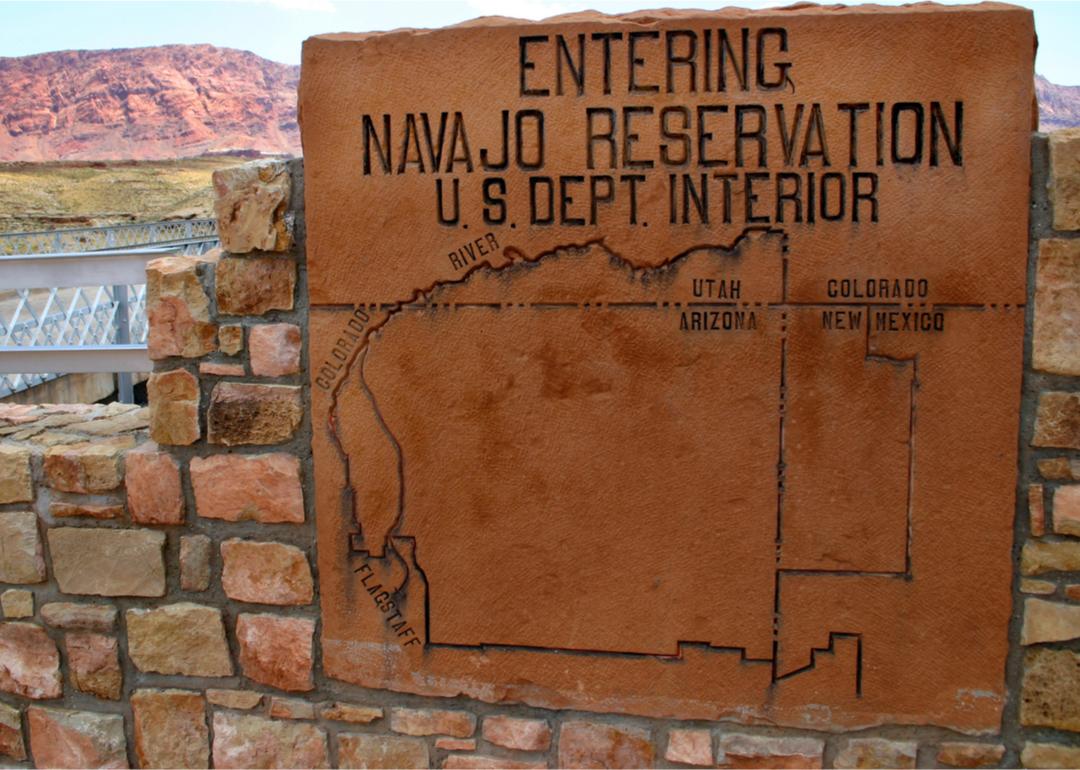
Autumn’s Memories // Shutterstock
#24. Utah
– Native American population: 32,622
– Proportion of state’s population: 1.0% (#17 highest among all states)
The Navajo comprise the biggest group of Native Americans in Utah, while the second-largest is the Northern Ute, with many living and working in urban areas. Several tribes have won settlement claims against the U.S. government for treaty violations, including the Ute, who won $47.7 million in 1962, as well as the Southern Paiutes and Goshutes in the 70s. These settlements have afforded tribes the right to self-determination over mineral extraction, water use, and business development on reservation lands.
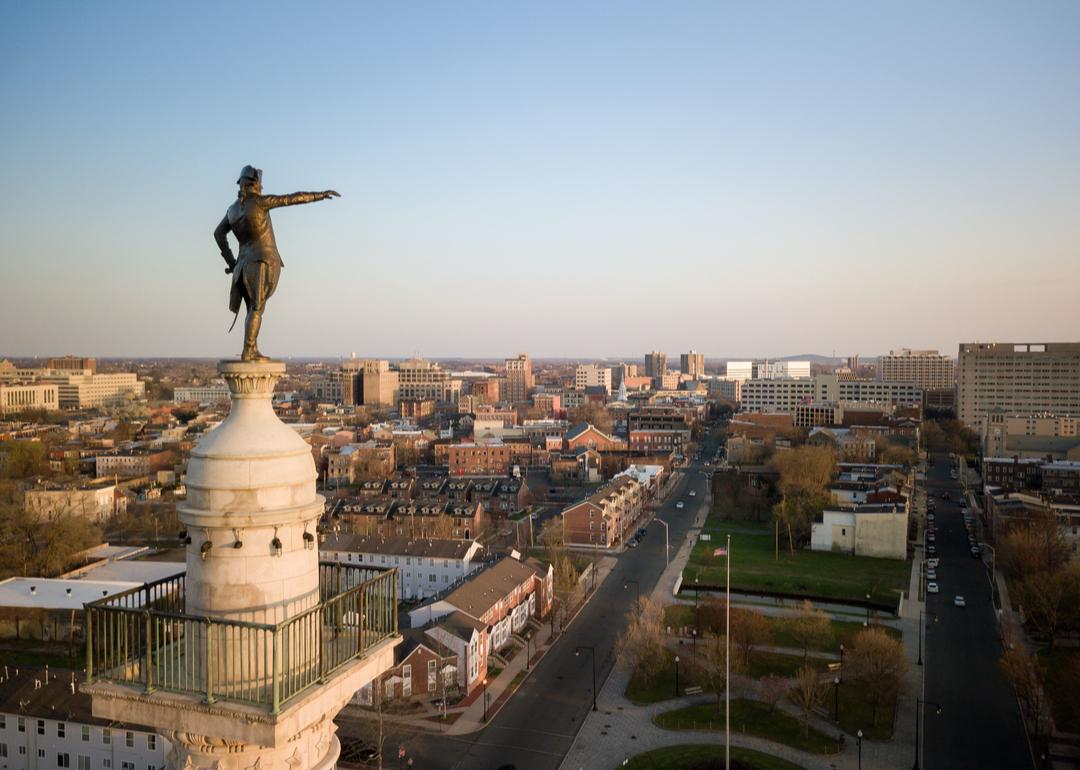
FotosForTheFuture // Shutterstock
#23. New Jersey
– Native American population: 35,727
– Proportion of state’s population: 0.4% (#33 highest among all states)
New Jersey recognizes three tribal nations: the Nanticoke Lenni-Lenape, the Ramapough Lenape, and the Powhatan Renape. The former is the largest and headquartered in southern New Jersey, part of a confederation with two tribes in Delaware that collectively oppose gambling operations and the sale of cigarettes and alcohol on religious and spiritual grounds.
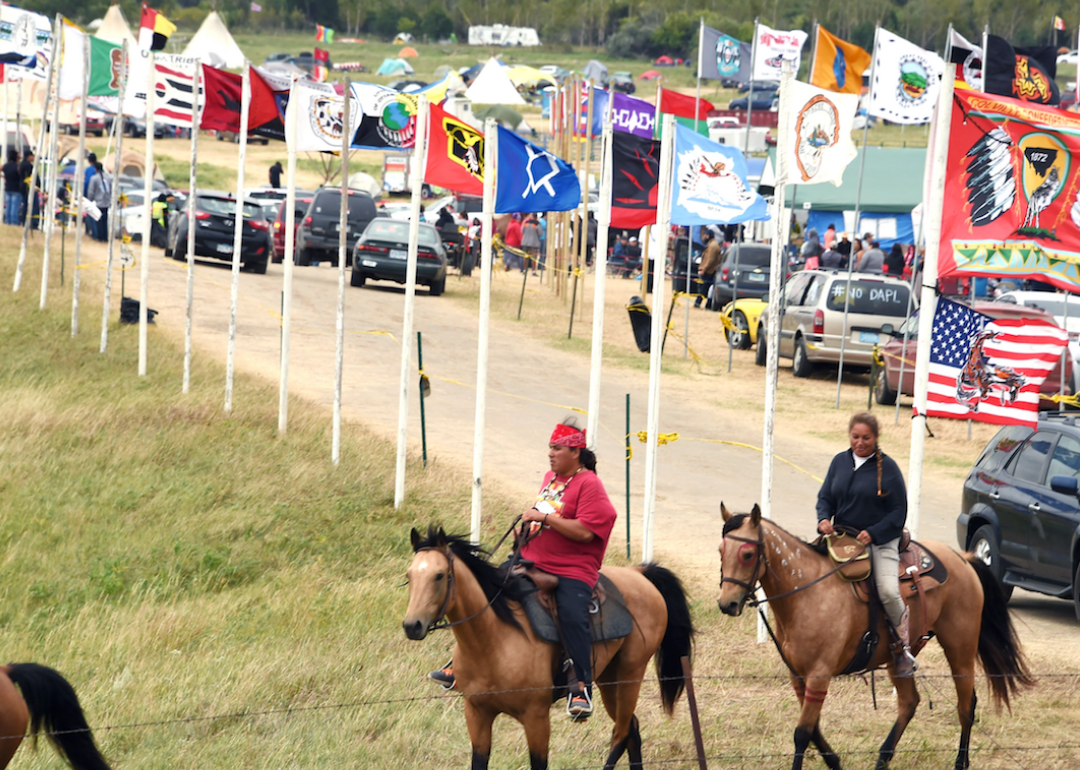
ROBYN BECK/AFP // Getty Images
#22. North Dakota
– Native American population: 35,955
– Proportion of state’s population: 4.6% (#6 highest among all states)
More than half of Native Americans living in North Dakota—where they are the largest minority population—live on one of its five reservations. The Standing Rock reservation was the site of protests against the $3.8 billion Dakota Access Pipeline that the Sioux, scientists, and environmentalists say will pollute water supplies. The fate of the oil pipeline has been in question since a judge threw out its permit to run under South Dakota’s Lake Oahe, a water source for the Sioux. President Joe Biden’s administration has since ordered a new environmental review of the situation, and in early 2022 the Supreme Court dismissed a case that looked to cancel the environmental review.
You may also like: History of rock ‘n’ roll
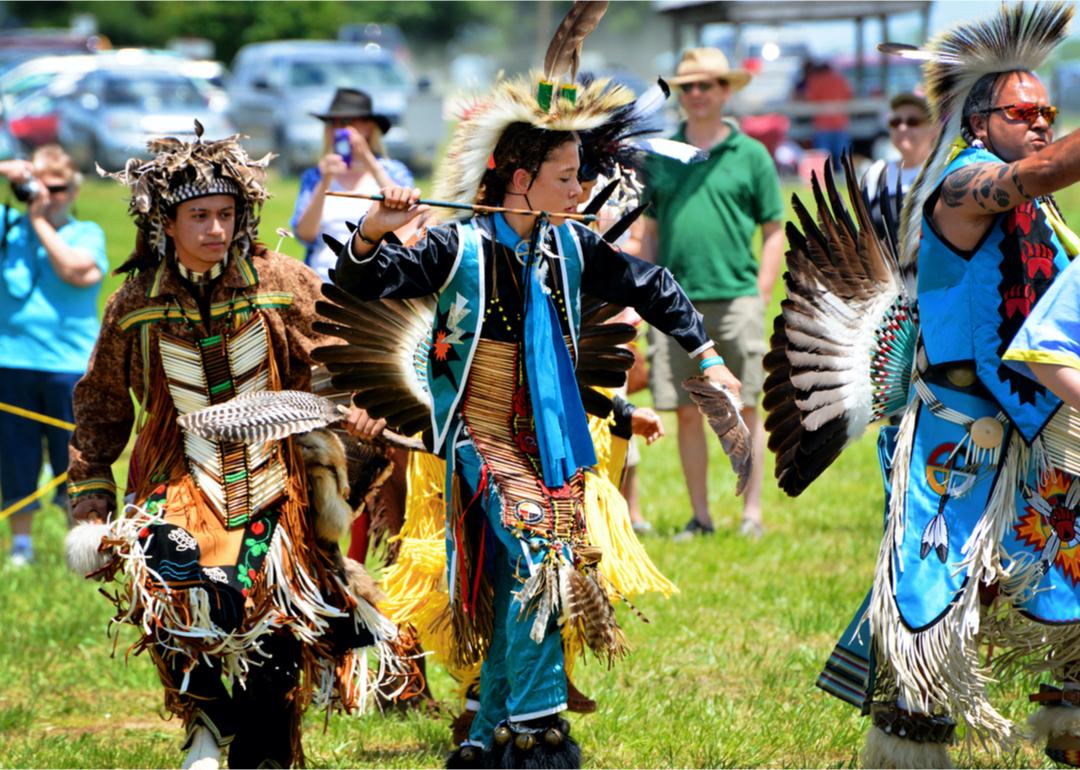
Kim Kelley-Wagner// Shutterstock
#21. Virginia
– Native American population: 37,018
– Proportion of state’s population: 0.4% (#31 highest among all states)
Virginia’s land along the Potomac and Anacostia river systems was home to the Pamunkey, Piscataway, Nentego, Monacan, Mattaponi, Chickahominy, and Powhatan people. It has two state-recognized reservations for the Pamunkey and Mattaponi tribes dating back to the 17th century, while several other lands designated for Indigenous people were encroached upon by colonists and disappeared. Among the peoples who once lived in the region were the Cherokee, who were forcibly removed and marched to Oklahoma.

Jacob Boomsma // Shutterstock
#20. Wisconsin
– Native American population: 42,107
– Proportion of state’s population: 0.7% (#21 highest among all states)
Eleven federally recognized tribes live in Wisconsin. Among them is the Menominee Indian tribe, whose reservation has more than 223,000 acres of virgin timberland, the largest single tract in the state. The Red Cliff Band of Lake Superior Chippewa operates Frog Bay Tribal National Park along the shoreline of Lake Superior, the country’s first tribal national park.
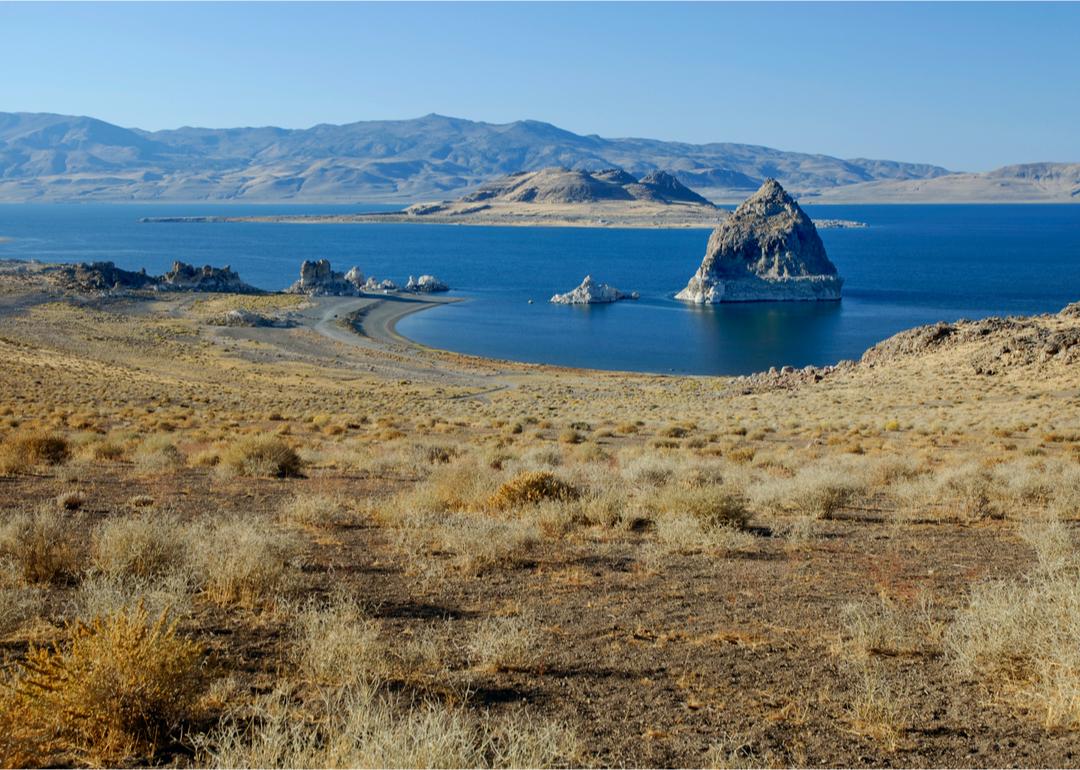
Terry W Ryder // Shutterstock
#19. Nevada
– Native American population: 44,661
– Proportion of state’s population: 1.4% (#9 highest among all states)
Nevada is home to a number of federal reservations and colonies. The major tribes are the Washoe, Northern Paiute, Southern Paiute, and Western Shoshone. Many have been hit disproportionately hard by the coronavirus and may have pre-existing health conditions or live in remote areas with limited access to medical care. In the Reno-Sparks Indian Colony, a clever color-coded card system was set up for people to signal from their windows for help with a health issue, food shortage, or other problem.
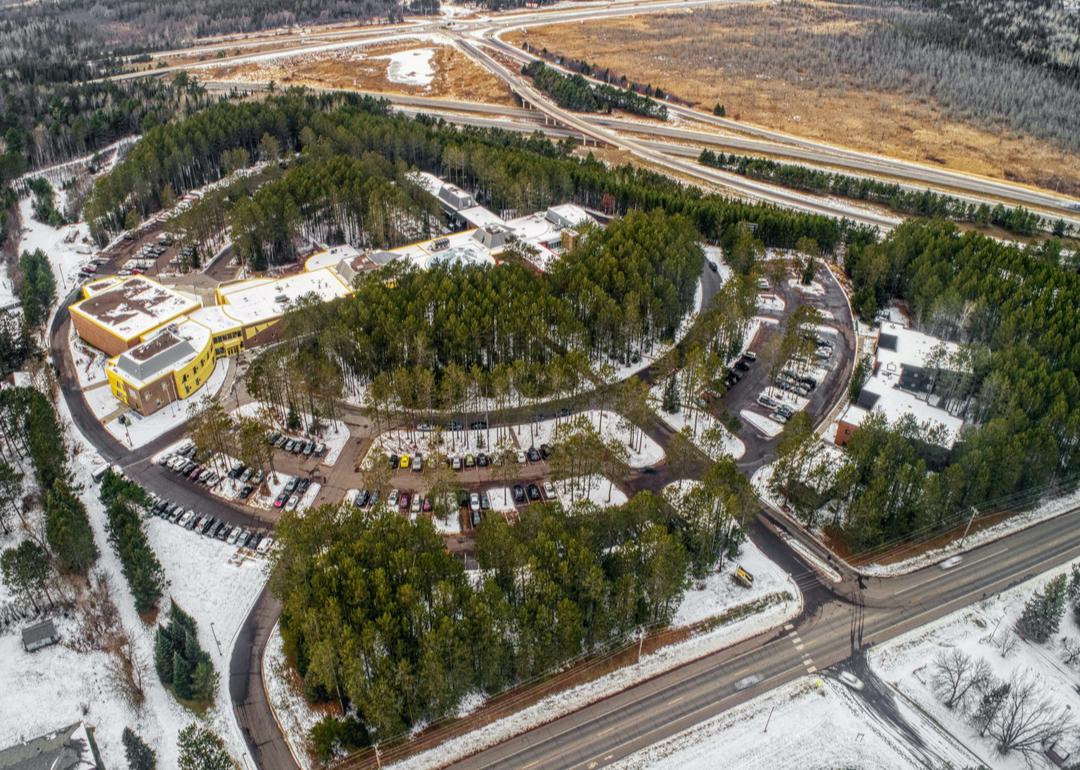
Jacob Boomsma // Shutterstock
#18. Minnesota
– Native American population: 48,309
– Proportion of state’s population: 0.8% (#18 highest among all states)
Minnesota was the ancestral home of the Sioux and Ojibwa, and it currently has seven Ojibwa reservations and four Sioux communities. Thousands of Ojibwa live in the Twin Cities of Minneapolis and St. Paul. Statewide, 12% of Native American adults and 22% of youths were homeless as of 2020.
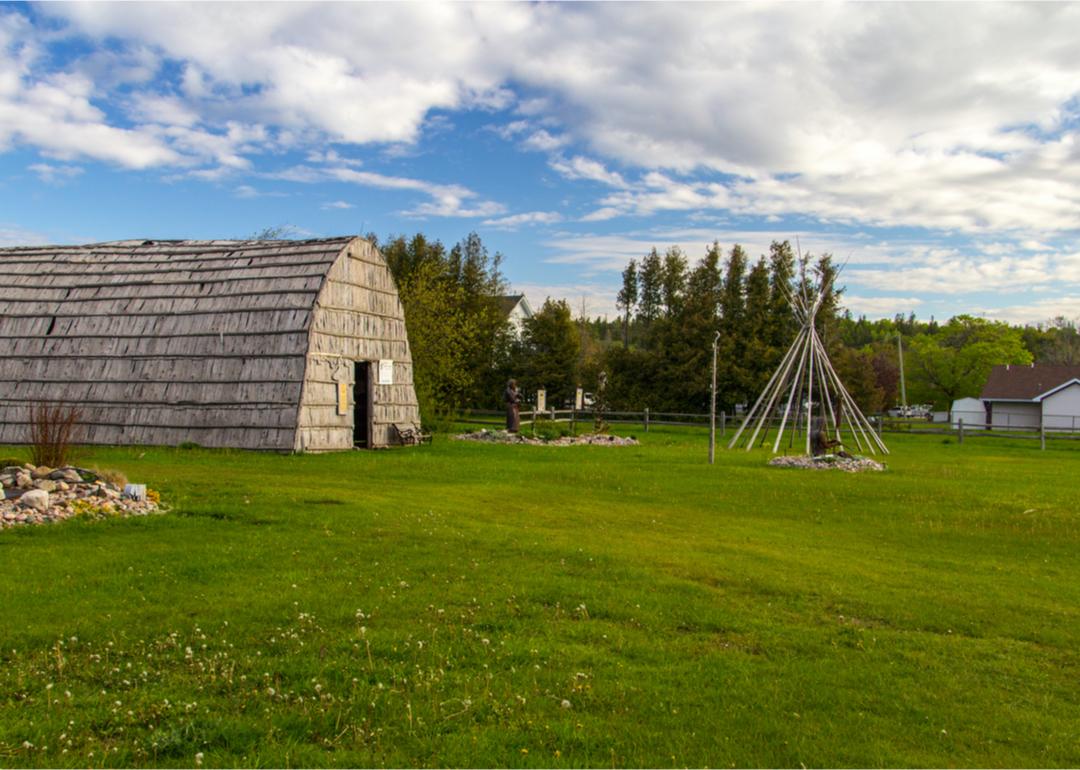
ehrlif // Shutterstock
#17. Michigan
– Native American population: 51,188
– Proportion of state’s population: 0.5% (#27 highest among all states)
Michigan’s Native American population includes the Chippewa, Ottawa, and Potawatomi tribes. The Pokagon Band of Potawatomi runs Mno-Bmadsen, an investment arm aimed at diversifying the tribe’s business portfolios. Despite years of public awareness efforts, in 2020 the Michigan Civil Rights Commission found that more than three dozen schools in the state use Native American mascots, imagery, or names.
You may also like: 50 famous firsts from presidential history
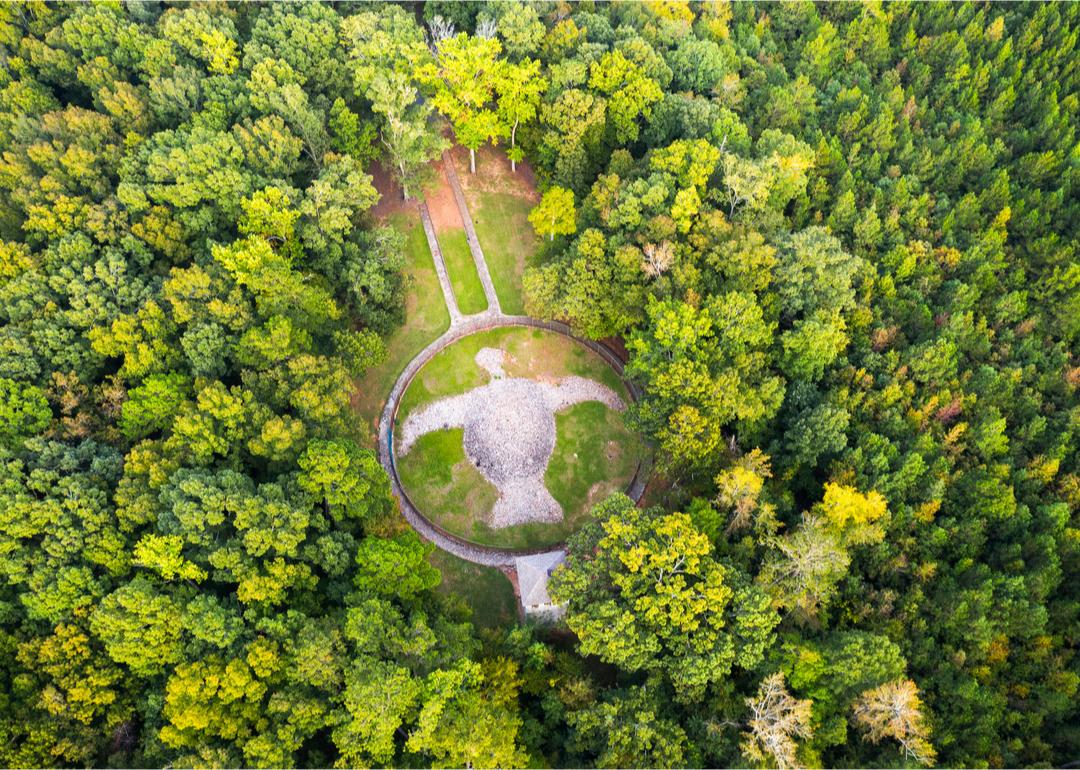
Sean Pavone // Shutterstock
#16. Georgia
– Native American population: 53,642
– Proportion of state’s population: 0.5% (#28 highest among all states)
Most of Georgia’s Native Americans were Cherokee, driven out nearly two centuries ago on the infamous Trail of Tears. While no federally recognized tribe lives within the state’s borders, the three recognized by the state are descendants of those who managed to stay behind, likely by hiding or intermarrying with white settlers. They include the Cherokee Indians of Georgia, Georgia Tribe of Eastern Cherokee, and Lower Muscogee Creek Tribe.
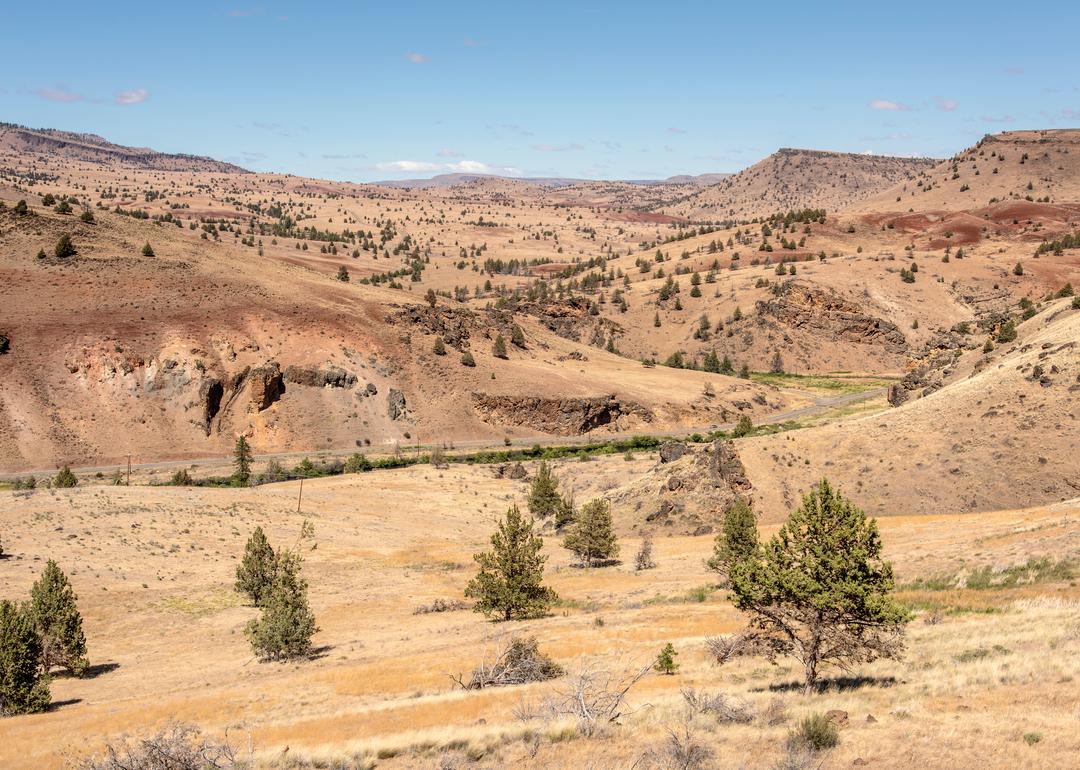
Rigucci // Shutterstock
#15. Oregon
– Native American population: 56,281
– Proportion of state’s population: 1.3% (#11 highest among all states)
Nine federally recognized tribes live in Oregon, where there are nine recognized reservations. But three-fourths of the state’s Native American population live off reservations, often in urban centers like Portland, where they have struggled with racism and discrimination. In 2017, the state legislature approved a measure ordering state schools to create curriculums on Native American experiences, tribal histories, and current events.
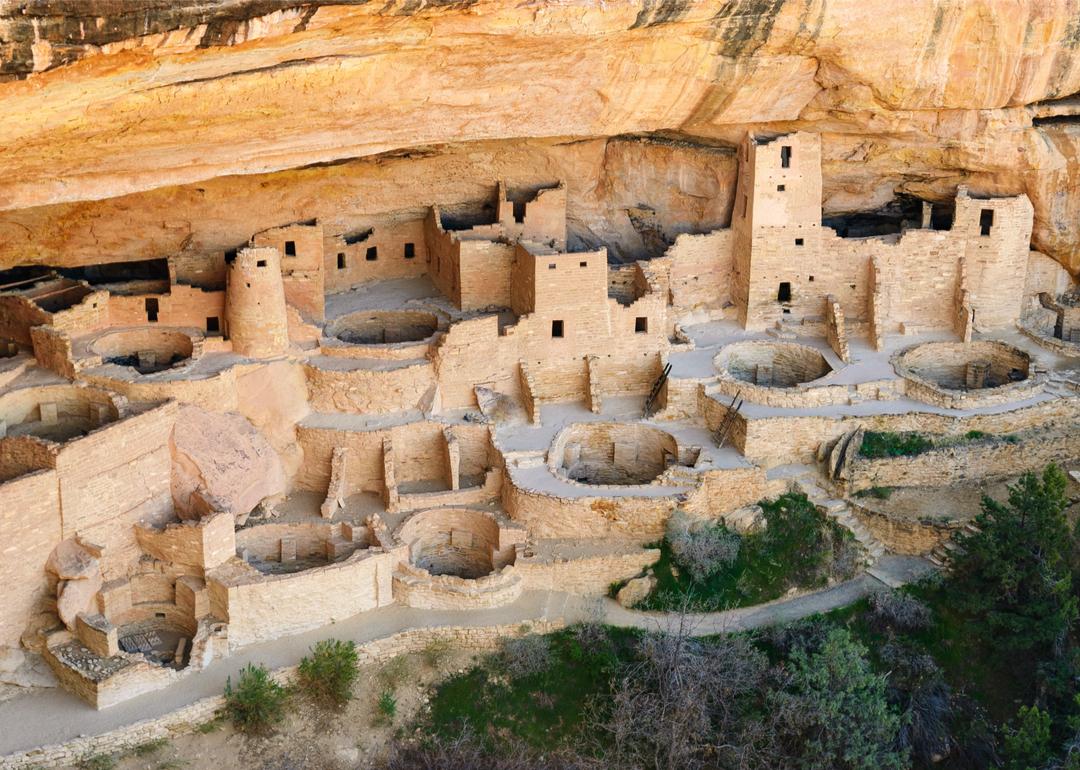
Zack Frank // Shutterstock
#14. Colorado
– Native American population: 60,377
– Proportion of state’s population: 1.0% (#16 highest among all states)
Most of Colorado’s Indigenous population live in urban areas, especially the Denver metro area. They include descendants of the Lakota, Cheyenne, Kiowa, Navajo, and some 200 other nations. The largest group is the Lakota, while the Navajo is the fastest-growing. The state has just two federally recognized reservations: one belonging to the Southern Utes, whose economy relies on oil and gas production, and the other belonging to the Ute Mountain Utes, who largely rely on tourism.
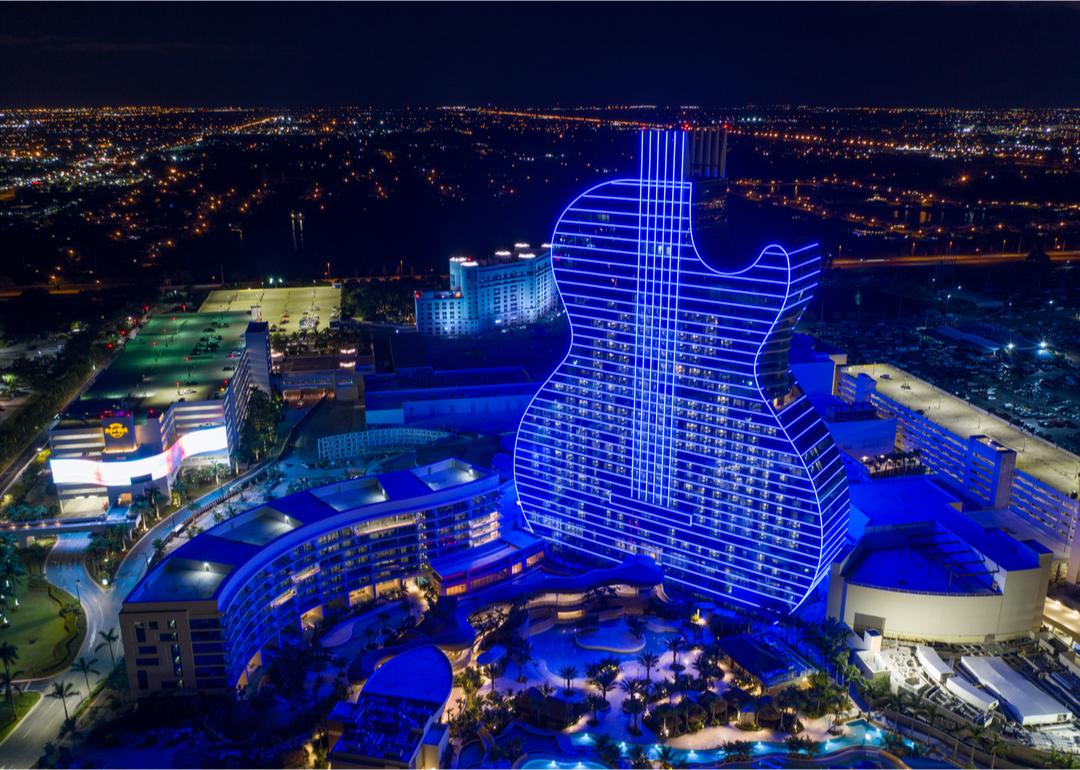
Felix Mizioznikov // Shutterstock
#13. Florida
– Native American population: 63,540
– Proportion of state’s population: 0.3% (#41 highest among all states)
Two federally recognized tribes, the Miccosukee and the Seminole, live in Florida, which has six reservations. The biggest is Big Cypress Indian Reservation, home to a major rock mine and a citrus grove of oranges, grapefruit, and tangerines. The Seminole, who started in gaming in 1979, have become one of the most successful tribes in the industry. Members with at least one-quarter Seminole blood share in the profits.
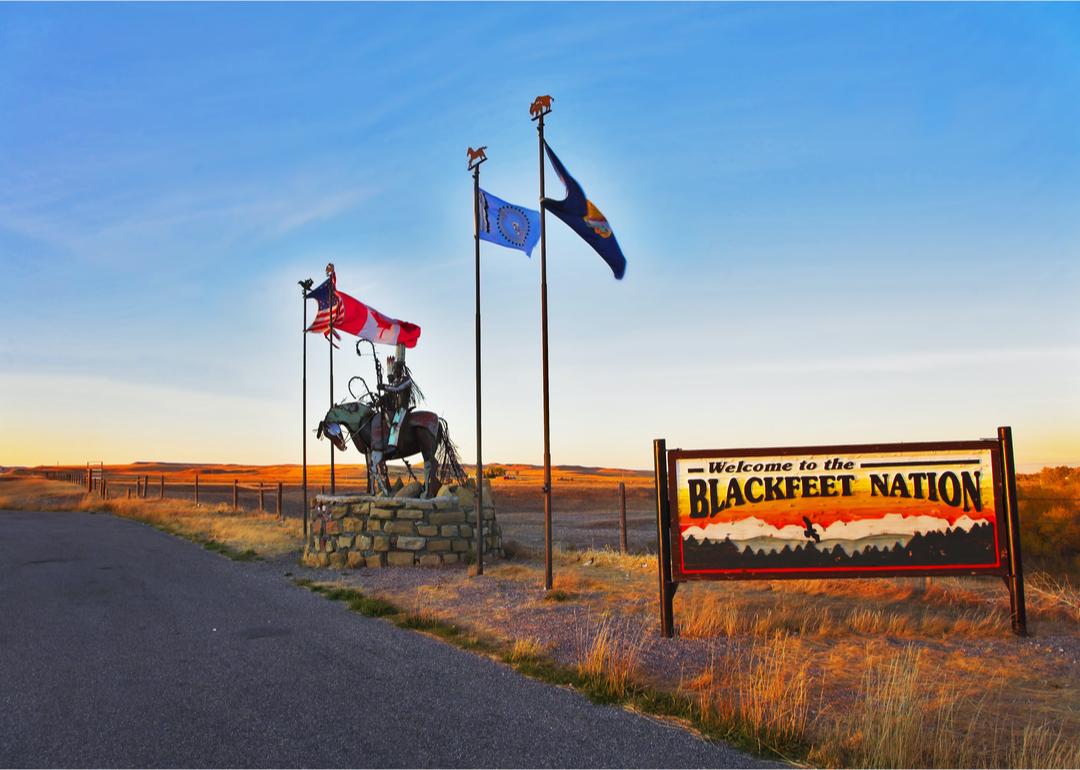
kavram // Shutterstock
#12. Montana
– Native American population: 63,896
– Proportion of state’s population: 5.8% (#5 highest among all states)
Seven federal reservations exist in Montana, including the Blackfeet, Rocky Boy, Crow, and Fort Peck. At Rocky Boy, the smallest reservation located in the Bear Paw Mountains, about half the population lives in poverty. The tribe owns a ski area and a steel plant, but jobs are scarce at its remote location. At Fort Peck, methadone addiction has escalated to dangerous levels, putting pressure on its foster care system when babies are born addicted and parents are unable to care for their children.
You may also like: How weather has shaped human history
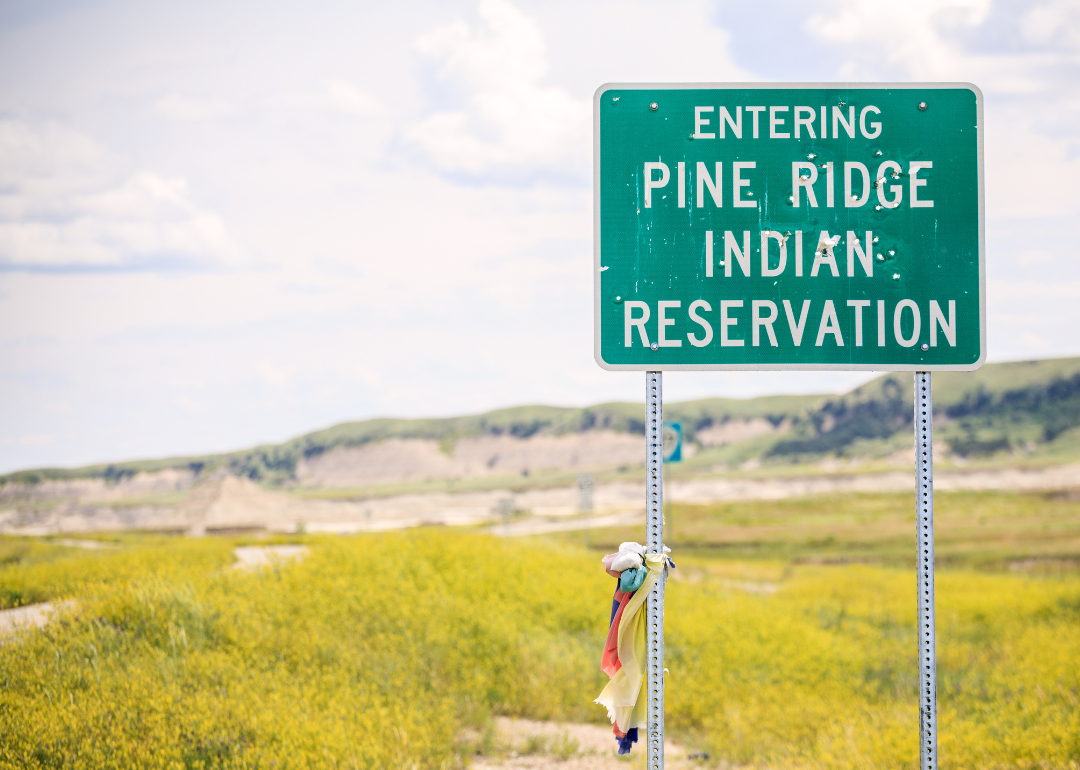
Sopotnicki // Shutterstock
#11. South Dakota
– Native American population: 73,115
– Proportion of state’s population: 8.2% (#3 highest among all states)
Pine Ridge Indian Reservation in South Dakota—at 2.1 million acres, one of the country’s largest—is the nation’s worst off by many measures. Its life expectancy is the lowest, its county of Oglala Lakota has the lowest per capita income, and its unemployment rate circa 2005 was 89%. Its school dropout rate is higher than 70%.
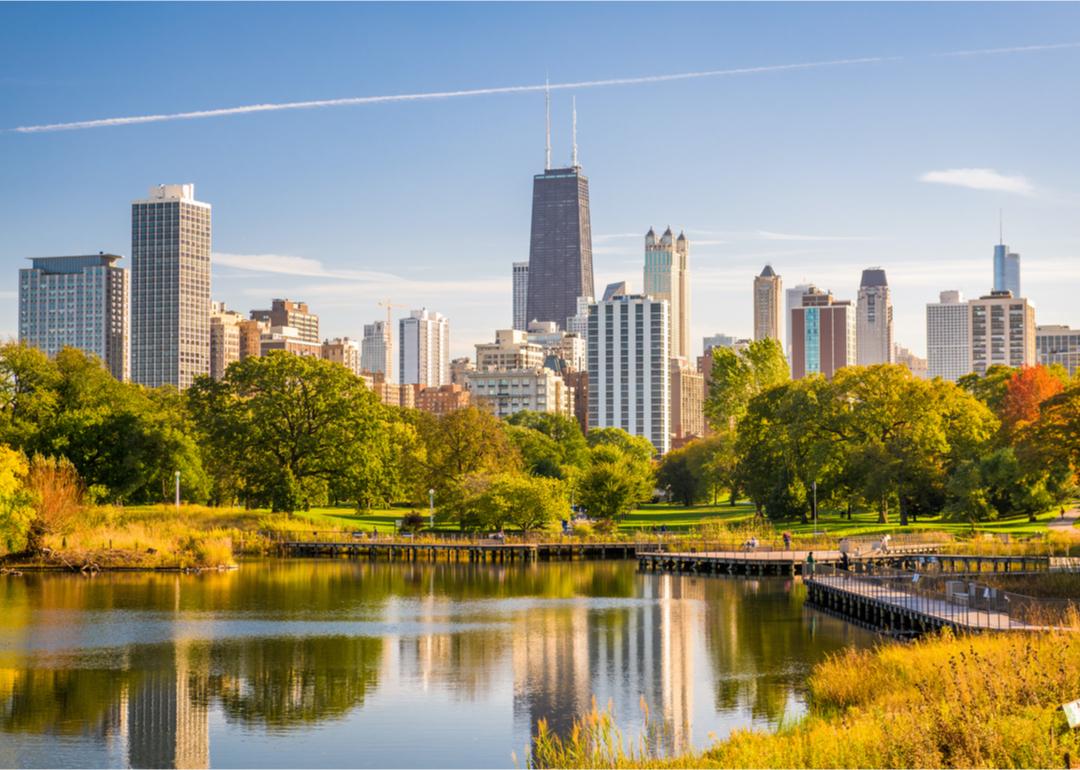
Sean Pavone // Shutterstock
#10. Illinois
– Native American population: 84,713
– Proportion of state’s population: 0.7% (#22 highest among all states)
Chicago is built on ancestral land once home to tribes linked by trading networks around the Great Lakes. In the 1950s, a government push encouraged Native Americans seeking jobs and skills training to move to cities such as Chicago, where they lived in poverty and substandard housing. Still, many remained: Chicago has the nation’s third-largest urban Native American population, drawn from 175 tribes.

CREATISTA // Shutterstock
#9. Alaska
– Native American population: 100,397
– Proportion of state’s population: 13.7% (#1 highest among all states)
Despite having 229 federally recognized tribes, Alaska has just one reservation, as land allotment from the federal government was handled differently compared with other states, and its tribal governments cannot collect taxes. Most Alaskan Natives live in small tribal communities, where they tend to be extremely poor. The poverty rate among Alaska Natives was nearly 24% in 2017, while it was less than 8% among whites.
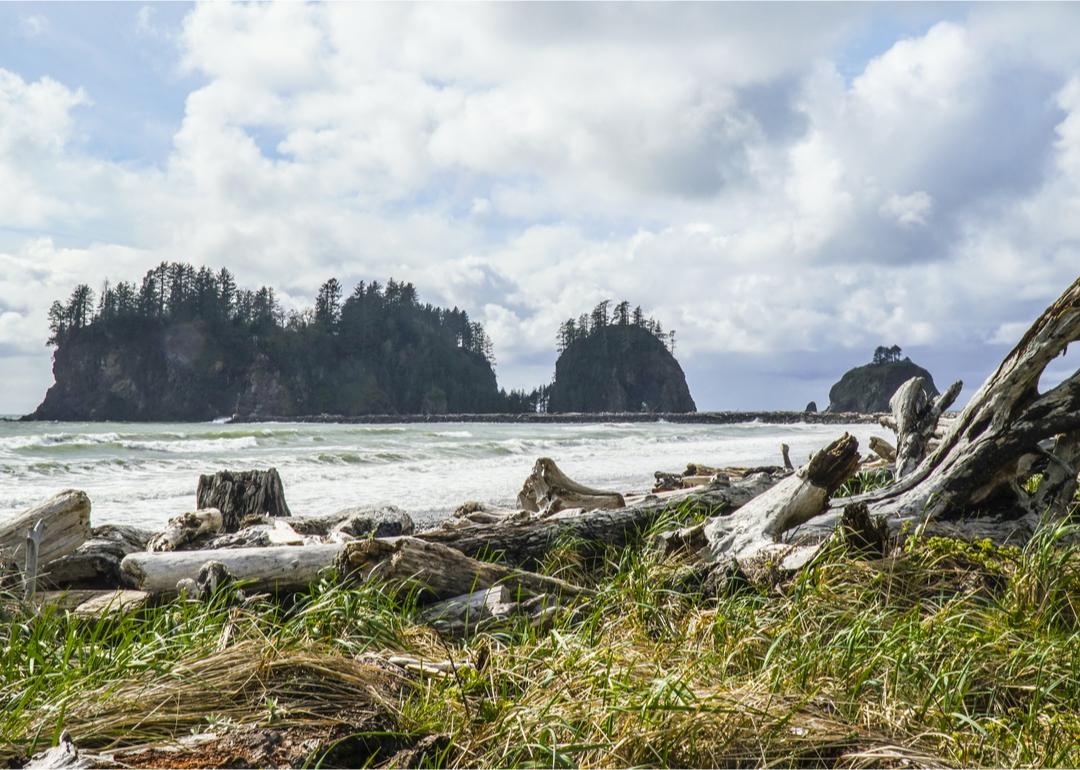
4kclips // Shutterstock
#8. Washington
– Native American population: 100,624
– Proportion of state’s population: 1.3% (#12 highest among all states)
Washington has 29 federally recognized tribes, the biggest of which is the Puyallup Tribe, which lives on Puget Sound on one of the nation’s most urban reservations. The reservation of the Confederated Tribes and Bands of the Yakama Nation in central Washington is more than 1 million acres, while the Squaxin Island Tribe maintains a 4.5-mile-long island in Puget Sound, which has no year-round residents but is reserved for tribal members to fish, hunt, and gather shellfish.

James R Poston // Shutterstock
#7. North Carolina
– Native American population: 116,742
– Proportion of state’s population: 1.1% (#15 highest among all states)
North Carolina has the biggest Native American population east of the Mississippi River, but only the Eastern Band of Cherokee Indians has federal recognition. The Cherokee once controlled about 140,000 square miles across eight states but were forced westward in the early 1800s, and those in North Carolina today descend from tribal members who managed to stay or return. Before the 1960s, Native Americans in North Carolina were treated with the same type of discrimination and systemic racism Black people faced, with separate schools, dining, and public facilities, and limited employment opportunities.
You may also like: History of the NRA
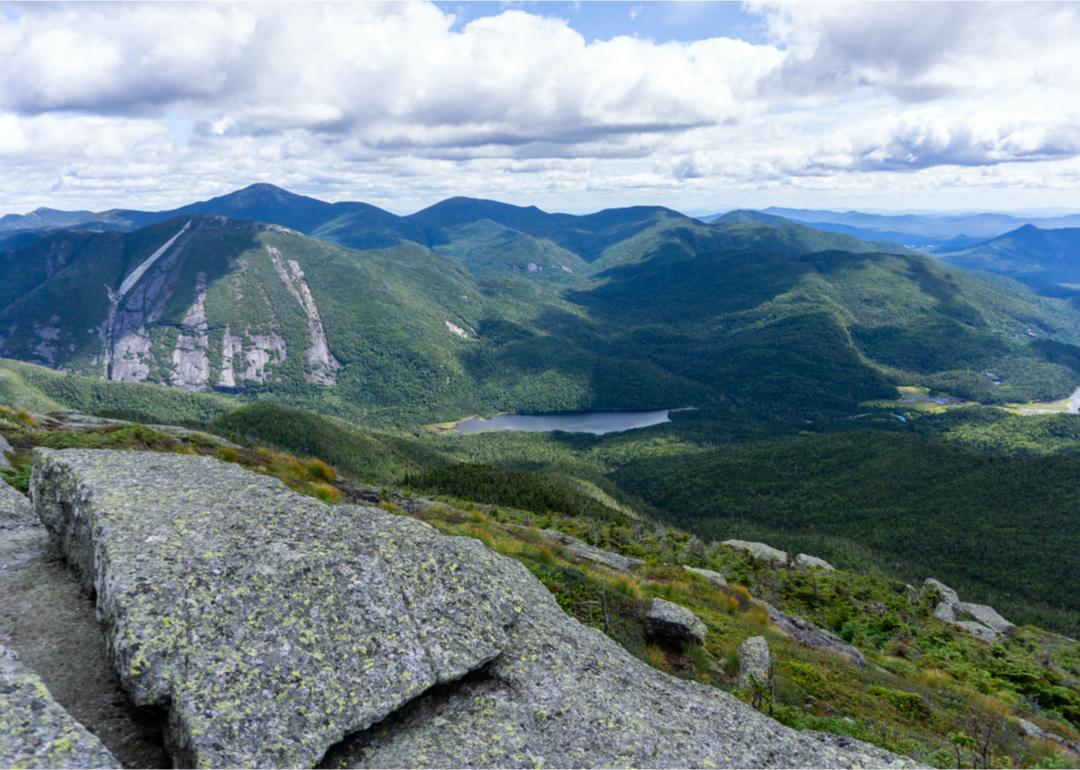
thehectorcompanion // Shutterstock
#6. New York
– Native American population: 119,692
– Proportion of state’s population: 0.6% (#23 highest among all states)
Among the tribes in modern-day New York are the Cayuga, Seneca, St. Regis Mohawk, and Oneida in the north and west, and the Shinnecock on Long Island, east of New York City. The Mohawk gained renown as fearless ironworkers, helping build the Empire State Building, Chrysler Building, and World Trade Center, among other city landmarks. Although the city’s high cost of living slowed the stream of Mohawks arriving to work on construction projects, Mohawk workers returned to help rebuild the World Trade Center in the years following the 9/11 attacks.
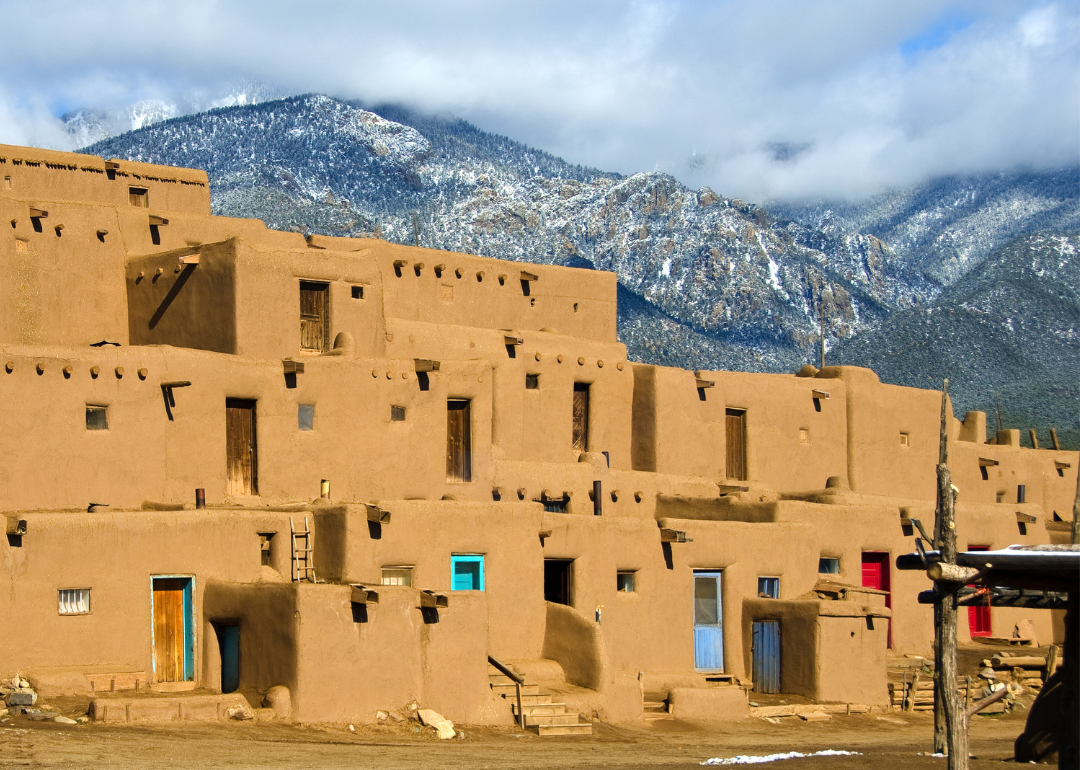
Dan Kaplan // Shutterstock
#5. New Mexico
– Native American population: 197,031
– Proportion of state’s population: 9.3% (#2 highest among all states)
New Mexico has 23 tribes: three Apache, 19 Pueblo, and the Navajo Nation. One of the best-known groups is the Taos Pueblo, whose village was designated a World Heritage Site in 1992 and has become a center for Southwestern art and architecture. Part of the sprawling Navajo Nation is located in northwestern New Mexico, as well as in northeastern Arizona and southeastern Utah. About a third of its 300,000 tribal members live in New Mexico.
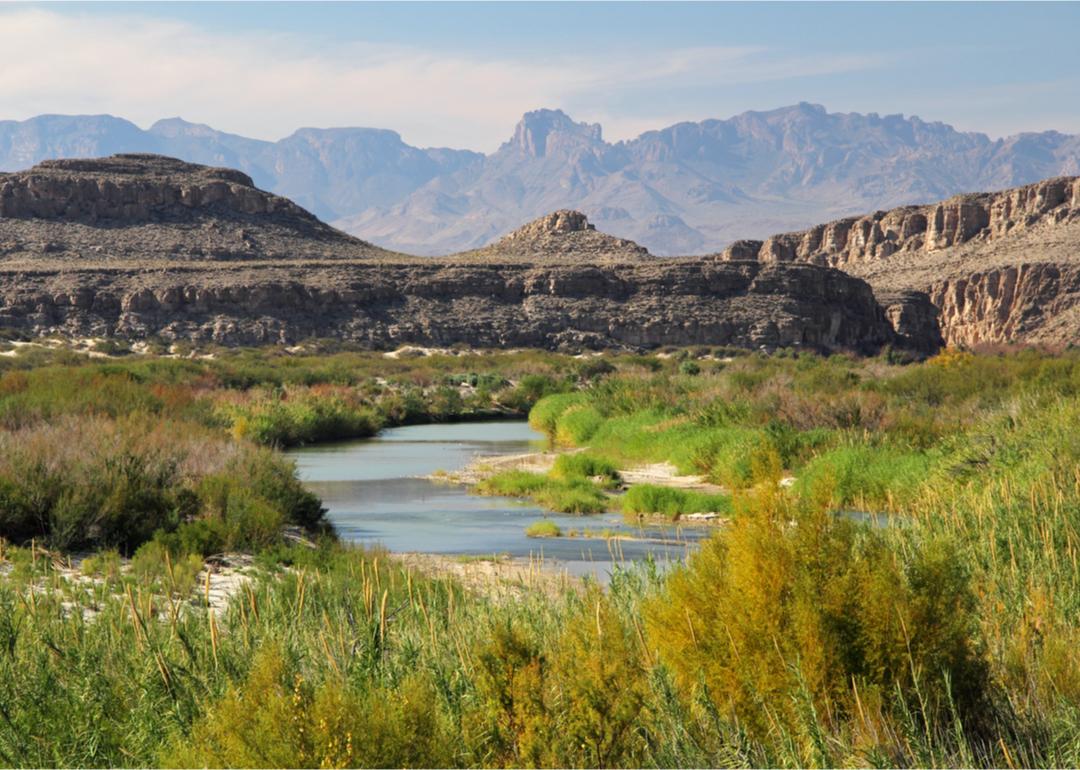
William Silver // Shutterstock
#4. Texas
– Native American population: 227,815
– Proportion of state’s population: 0.8% (#19 highest among all states)
Federal reservations in Texas belong to the Alabama-Coushatta, Tigua, and Kickapoo tribes, and the state-recognized Lipan Apache Tribe of Texas is headquartered in McAllen, along the Mexican border. From the 1950s through the 70s, the U.S. government relocated more than 10,000 Native Americans to the Dallas-Fort Worth area in an integration and assimilation effort, luring them with offers of jobs, education, and health care. Several thousand and their descendants remain.
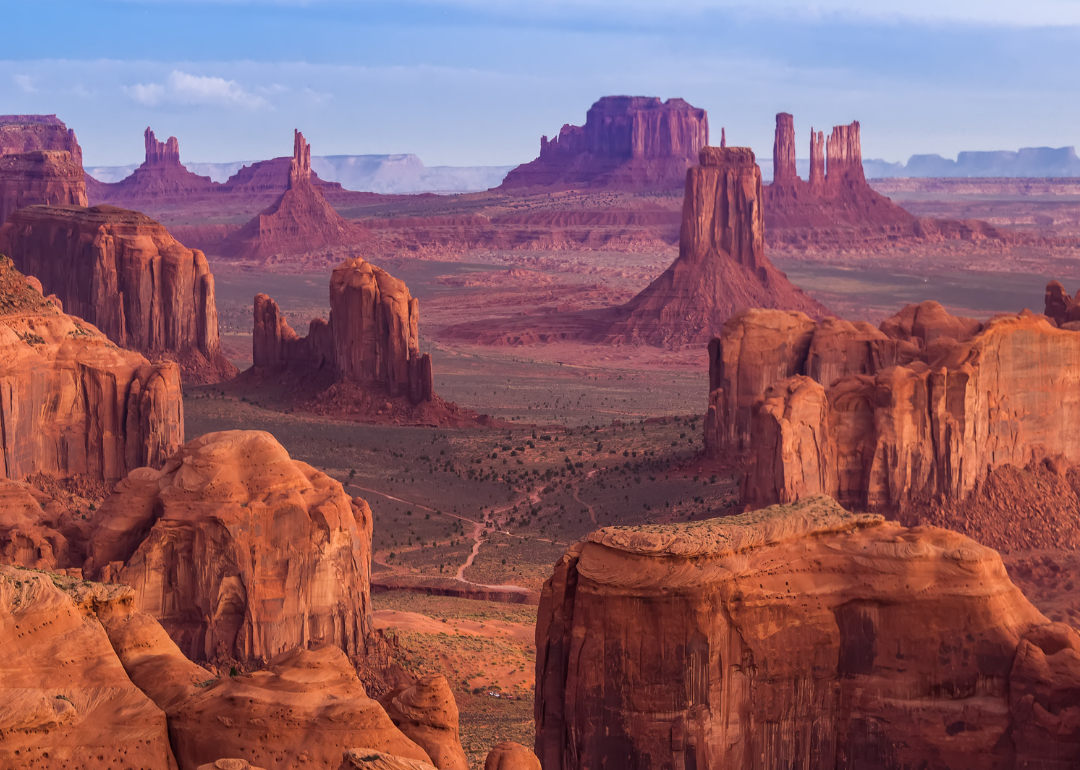
Zhukova Valentyna // Shutterstock
#3. Arizona
– Native American population: 294,658
– Proportion of state’s population: 4.0% (#7 highest among all states)
There are 22 federally recognized Native American tribes in Arizona, three of which extend across state lines. The largest reservation is located in the state’s northeastern corner, where the Navajo Nation, Hopi, and San Juan Southern Paiute share land. Among the region’s most well-known draws is the Monument Valley Navajo Tribal Park.
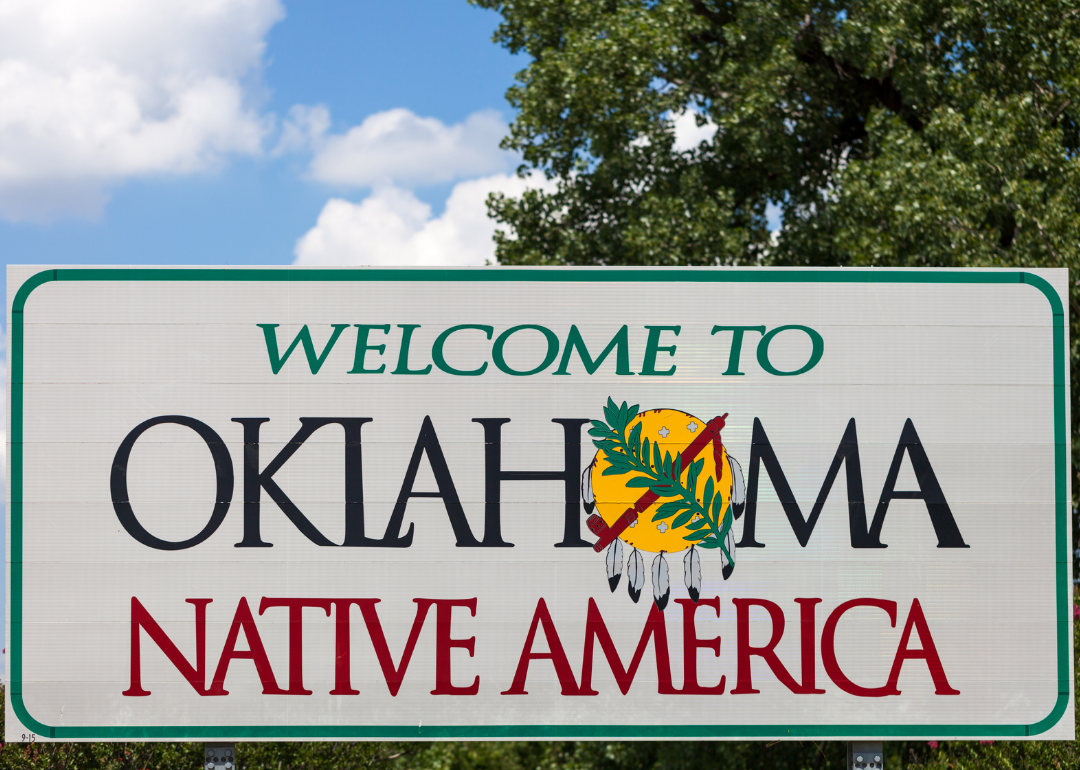
Moab Republic // Shutterstock
#2. Oklahoma
– Native American population: 297,937
– Proportion of state’s population: 7.5% (#4 highest among all states)
Native Americans in Oklahoma are descendants of tribes forced to move from the east in the early 1800s, including the Five Civilized Tribes (the Cherokee, Choctaw, Chickasaw, Creek, and Seminole). In July 2020, the Supreme Court ruled that more than 3 million acres, about half of Oklahoma, is Native American reservation land, including Tulsa, its second-largest city. This settled the question of whether the reservation remained in existence after Oklahoma became a state, and while the ruling won’t affect land ownership, it may have implications for jurisdictions and prosecutions.
You may also like: The cost of gasoline the year you started driving
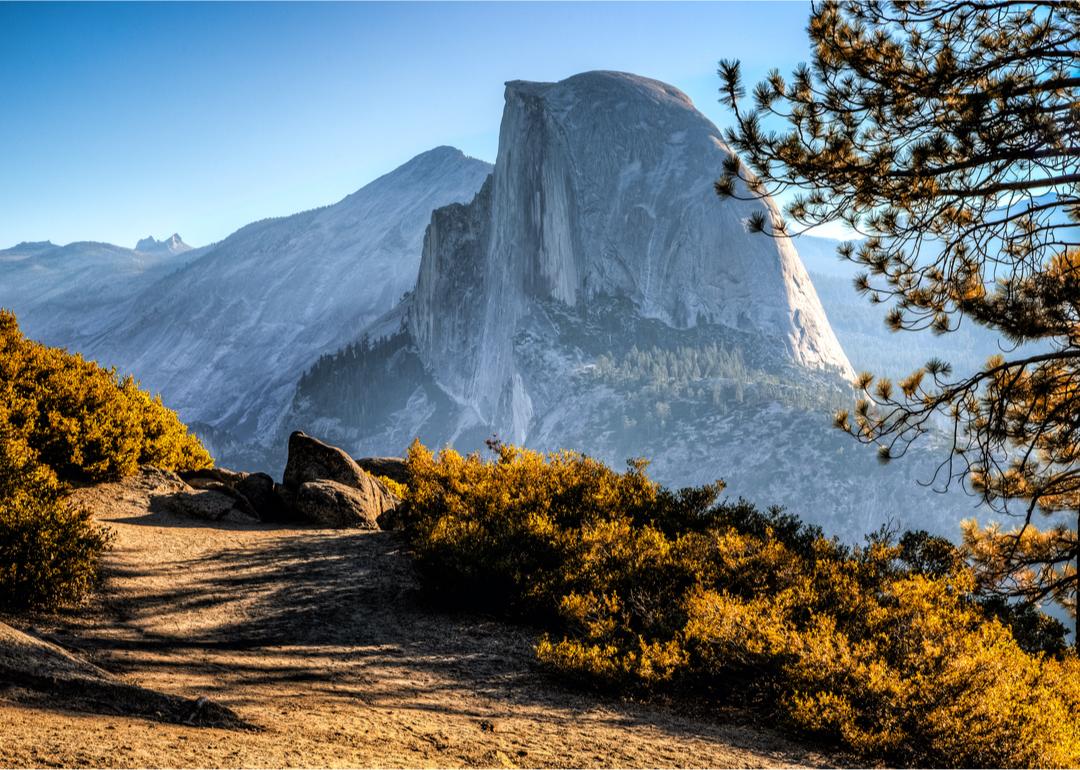
Stephen Moehle // Shutterstock
#1. California
– Native American population: 535,468
– Proportion of state’s population: 1.4% (#10 highest among all states)
Under federal relocation efforts that began in the 1950s, thousands of Native Americans left reservations to look for opportunities in Los Angeles and San Francisco. In 1969, activists occupied a decommissioned federal prison on Alcatraz Island for nearly two years, claiming it as Native American land. Tribes started holding bingo games in the late ’70s to generate revenue, leading to a dispute and ultimately a Supreme Court ruling that states didn’t have the authority to regulate gaming on Indian lands—effectively greenlighting casino development on Native American land.